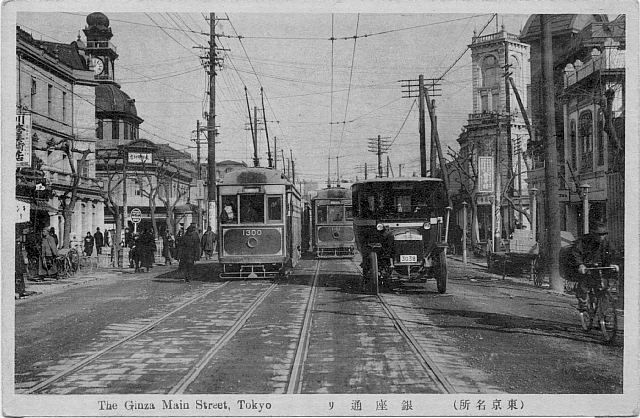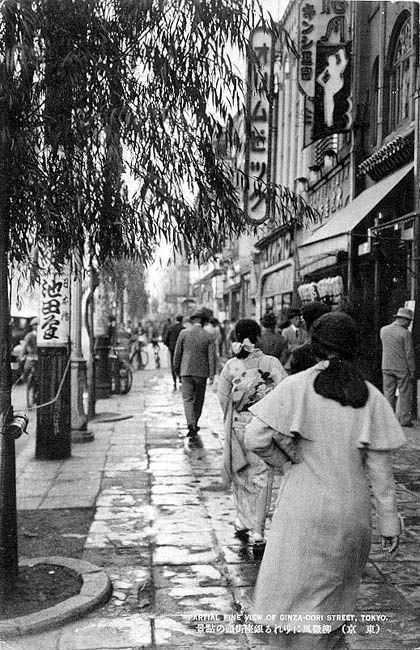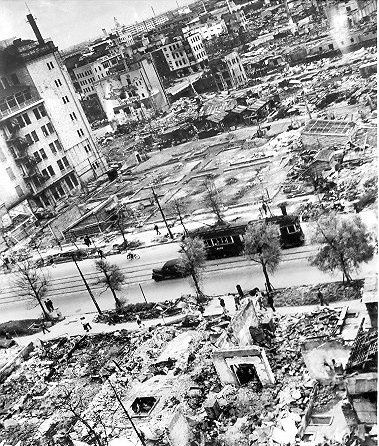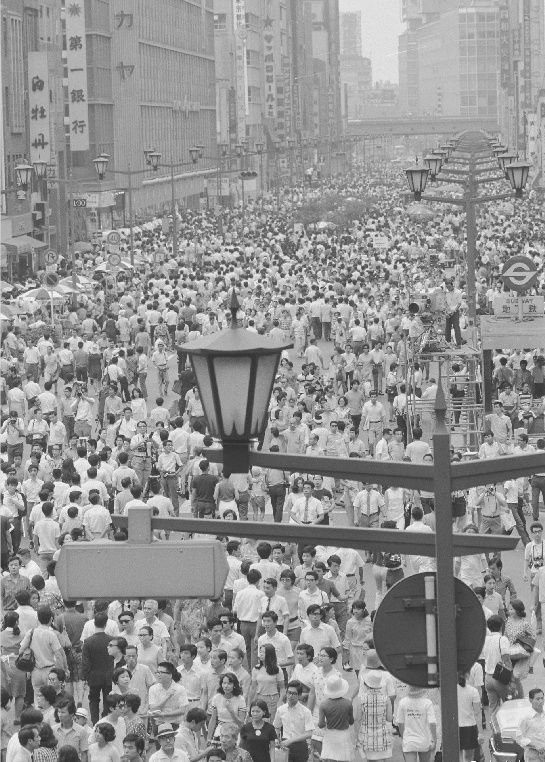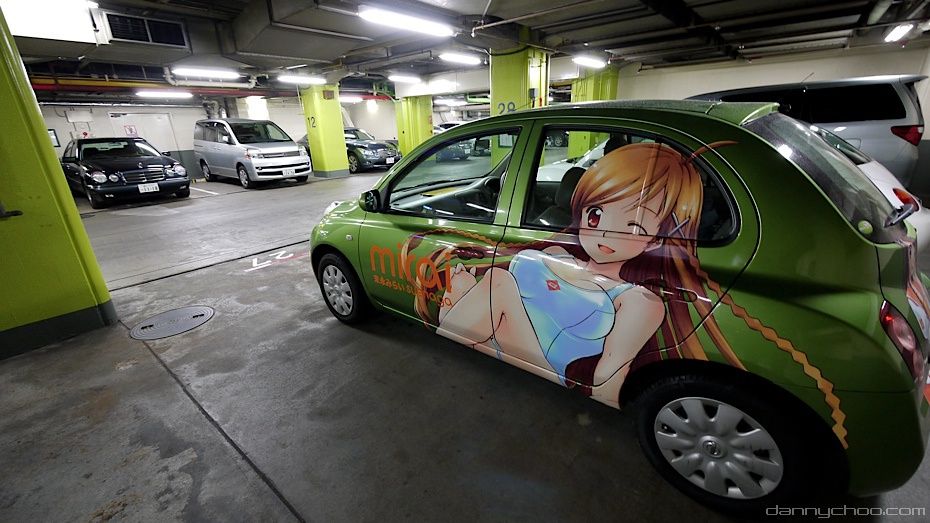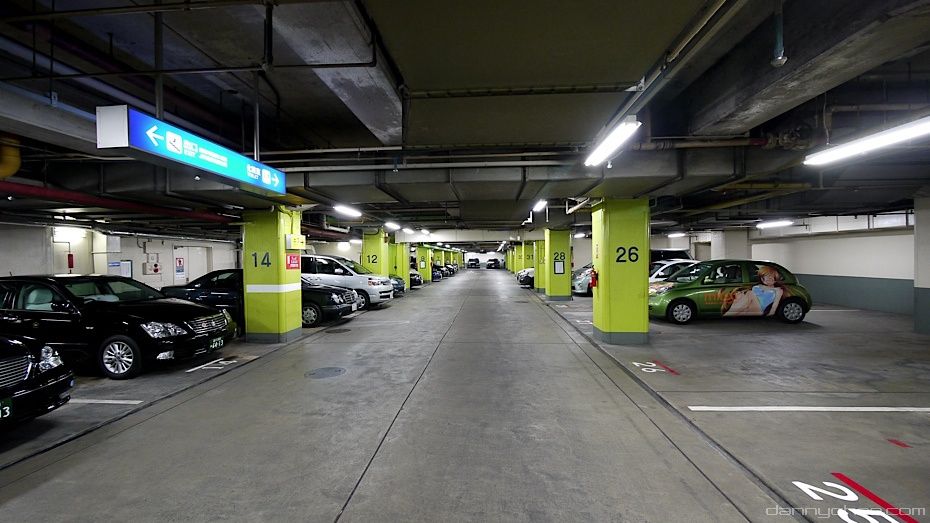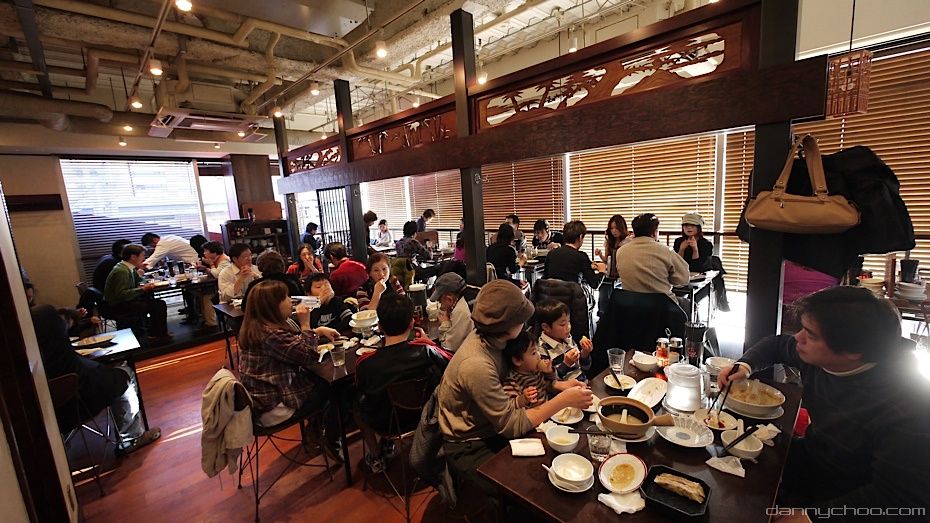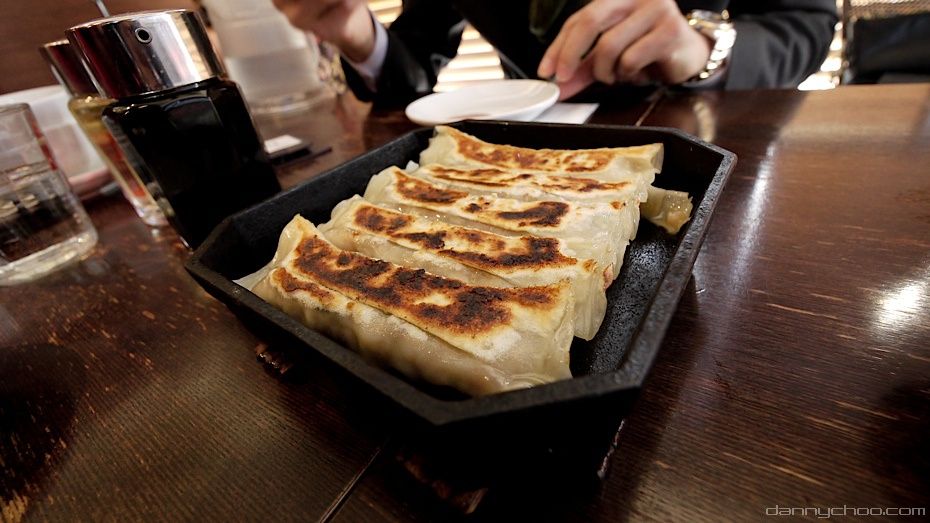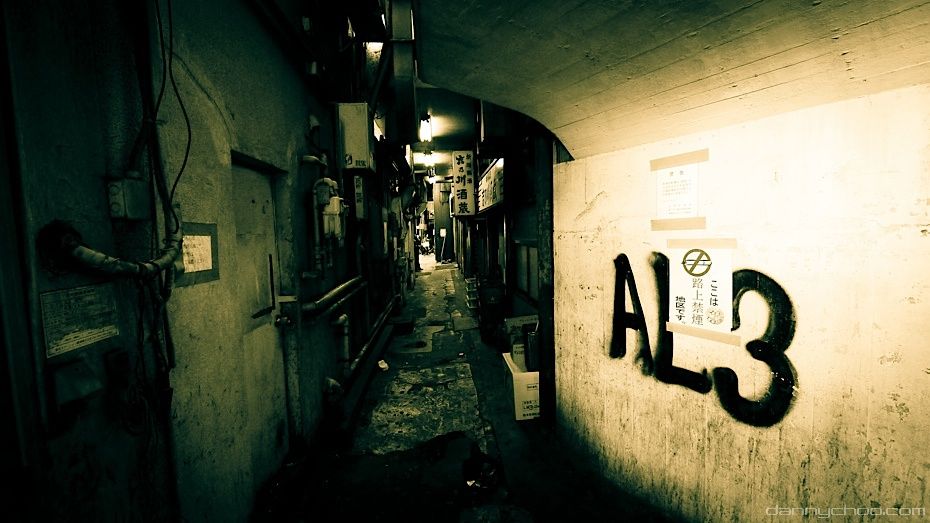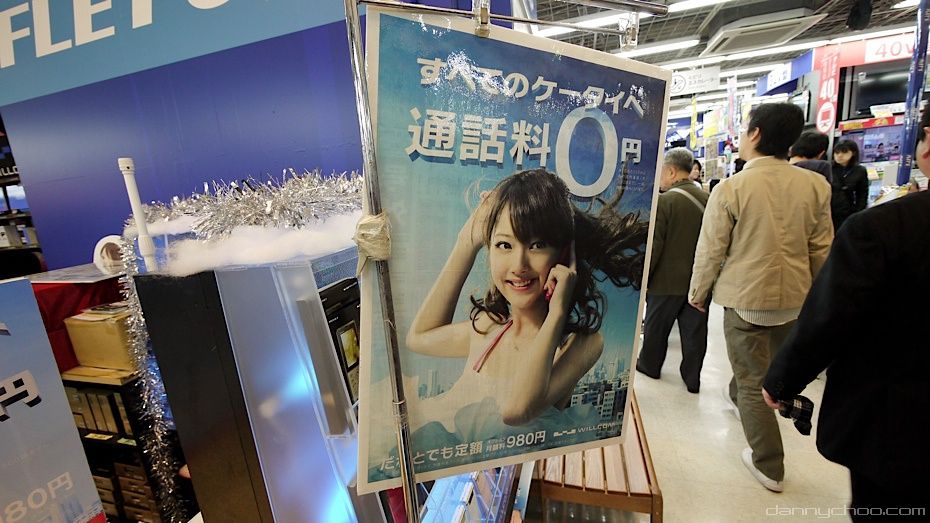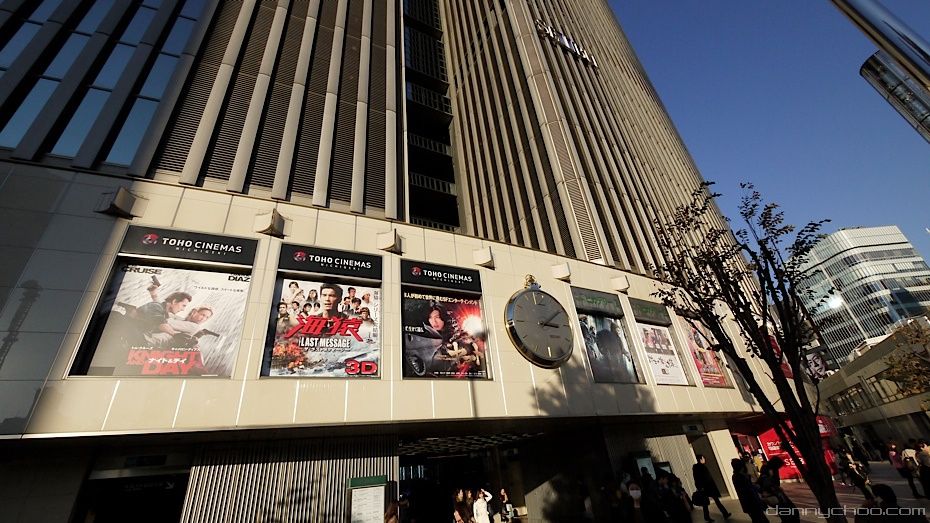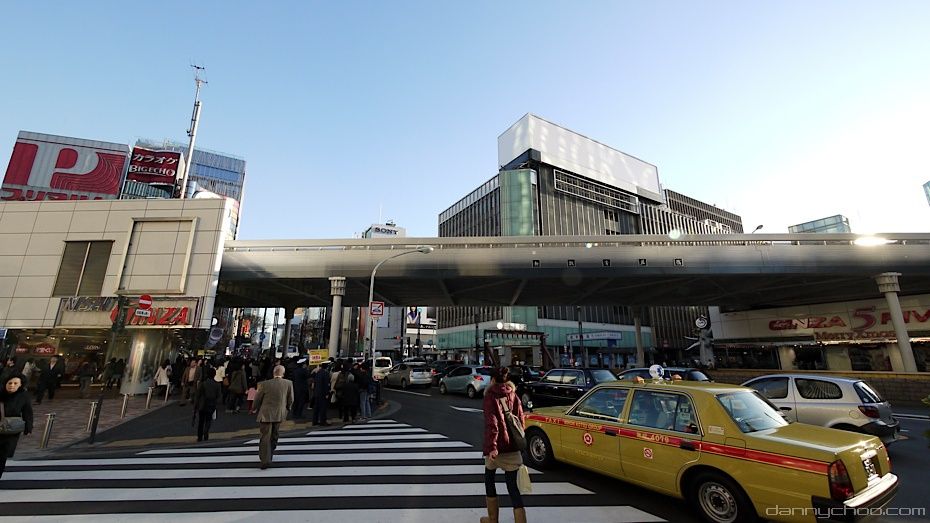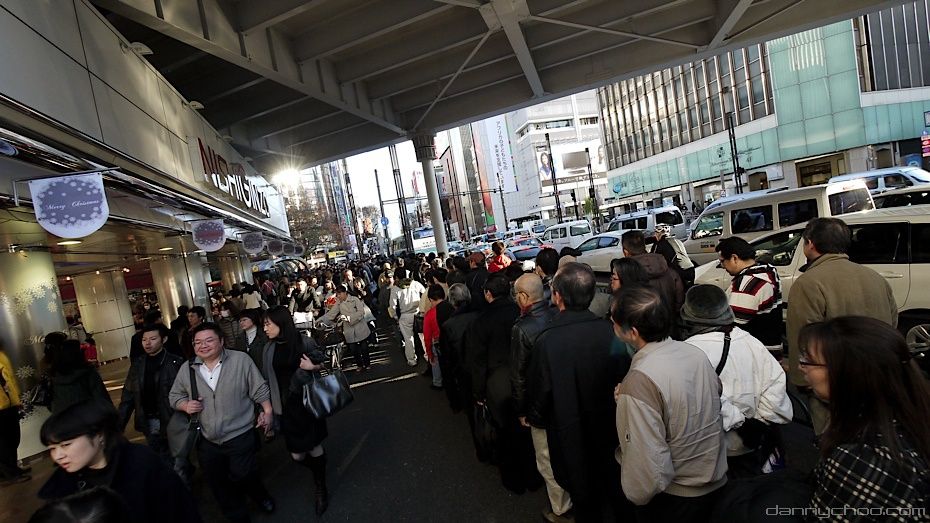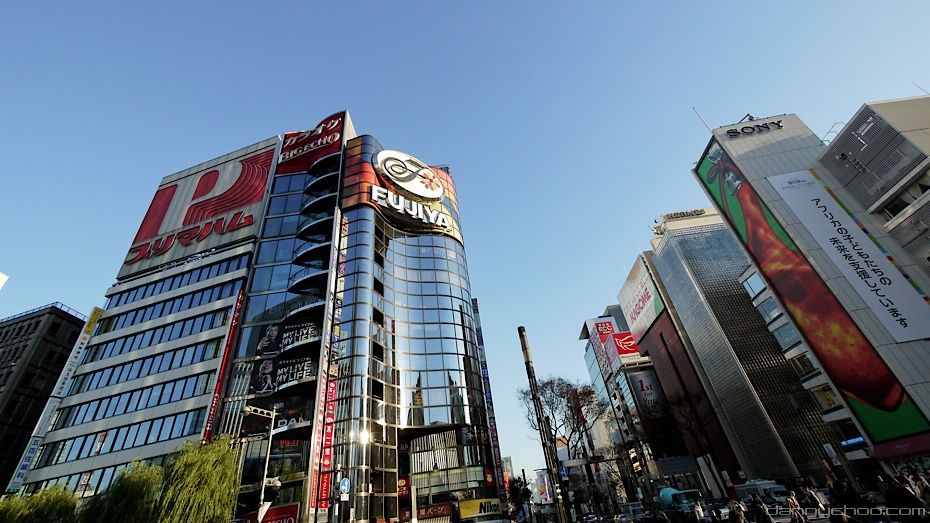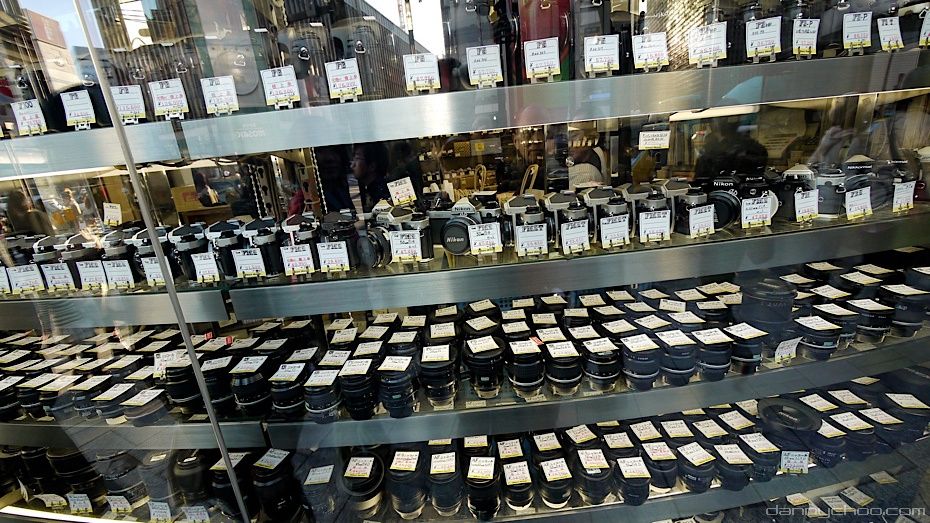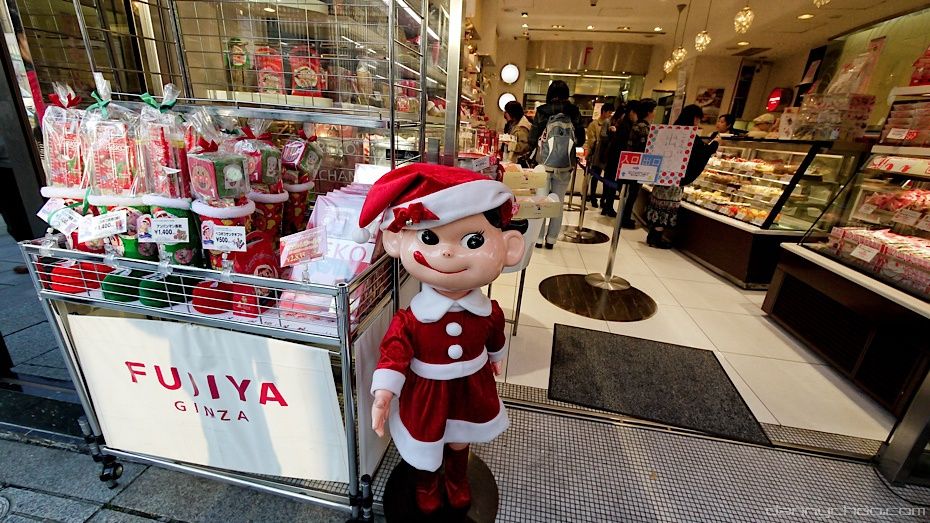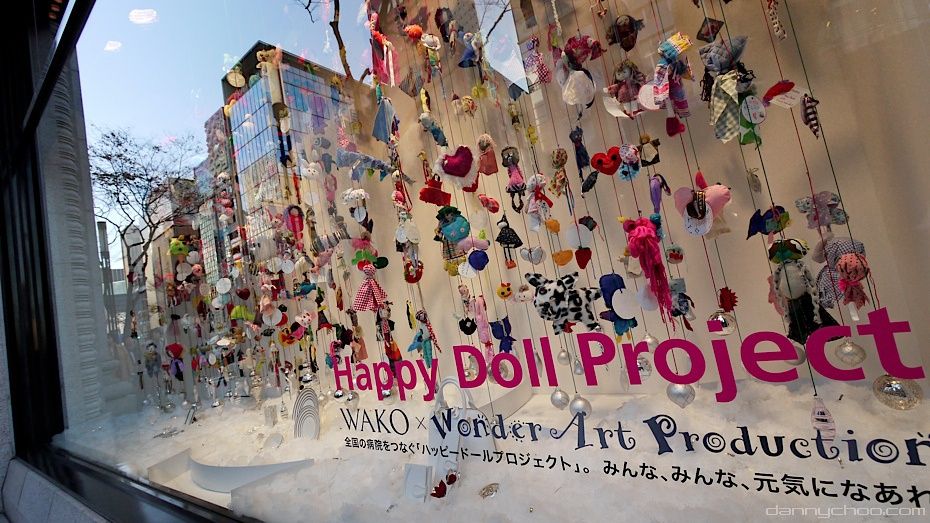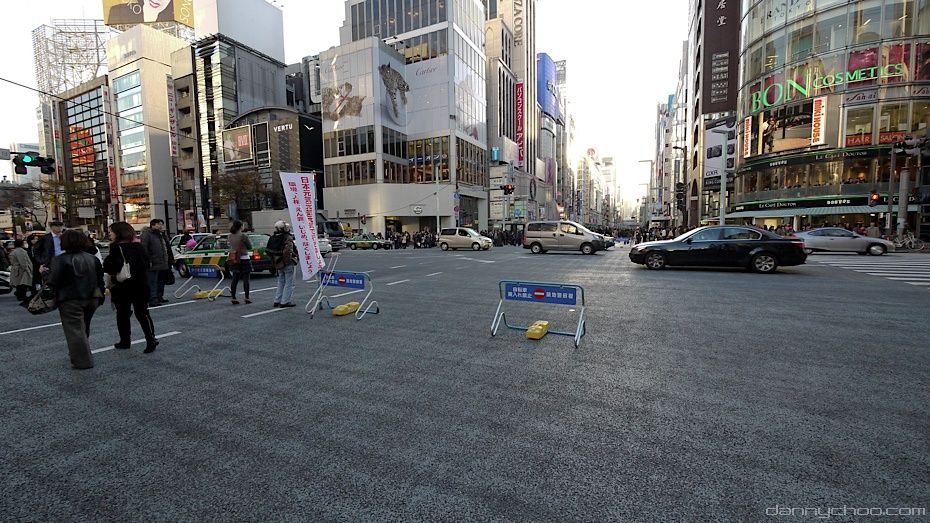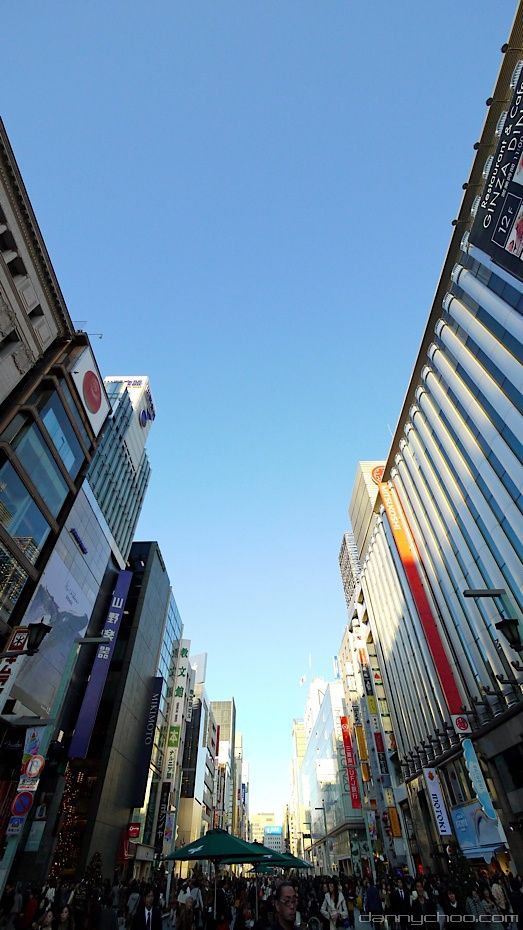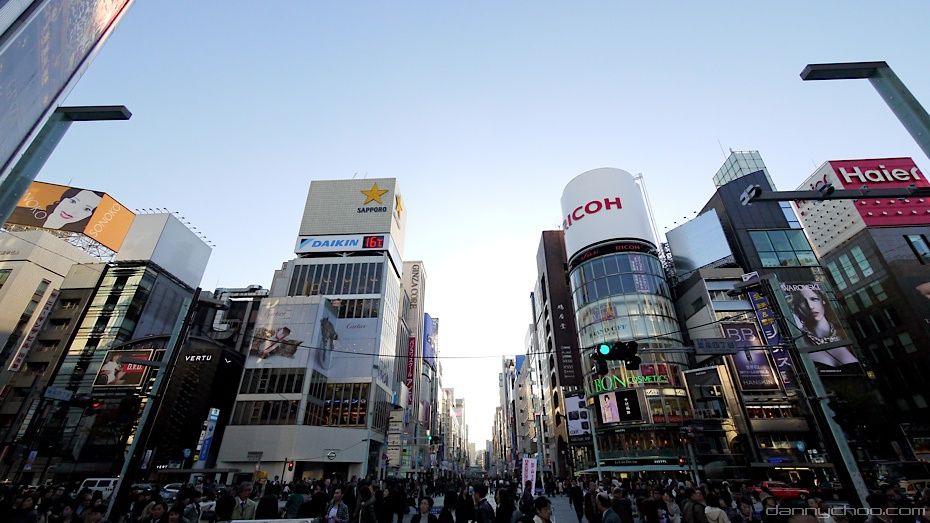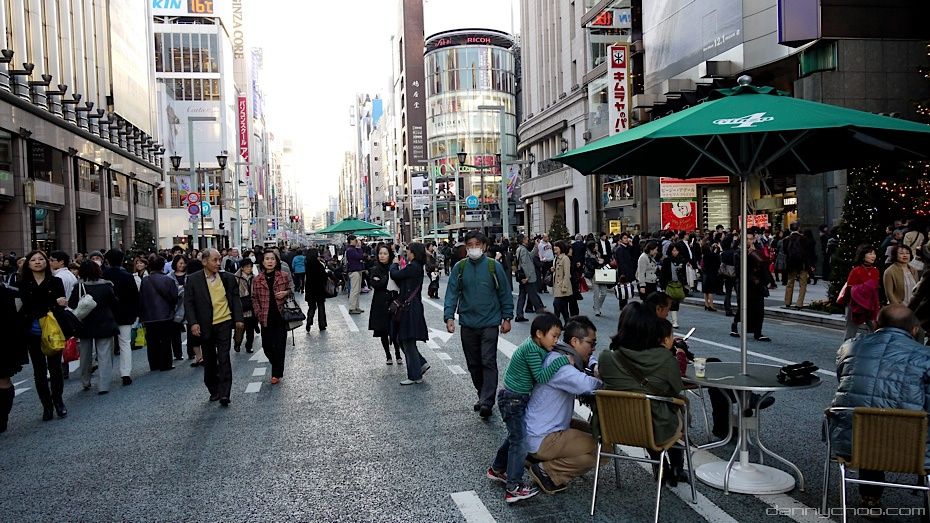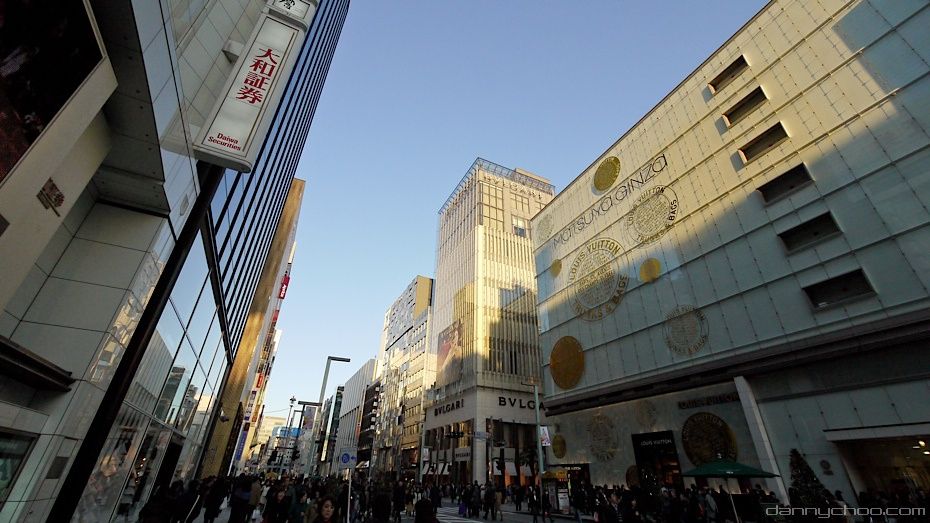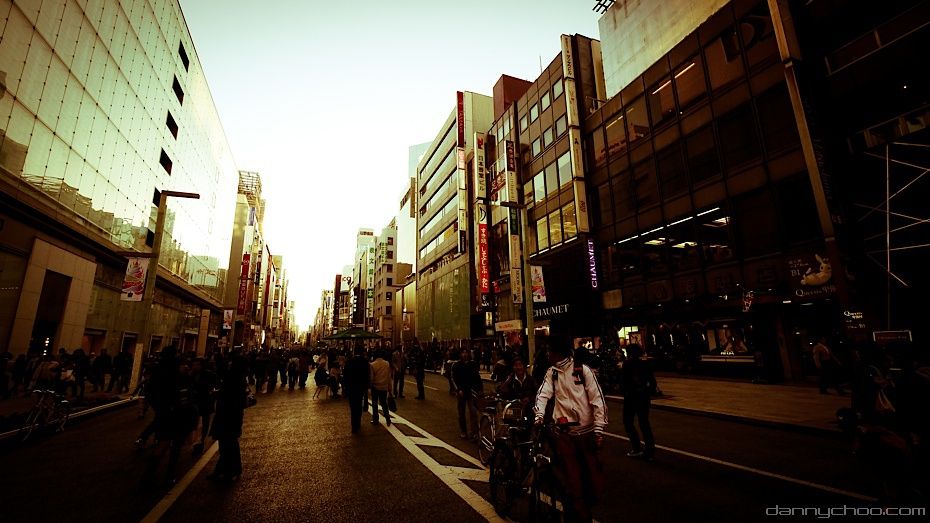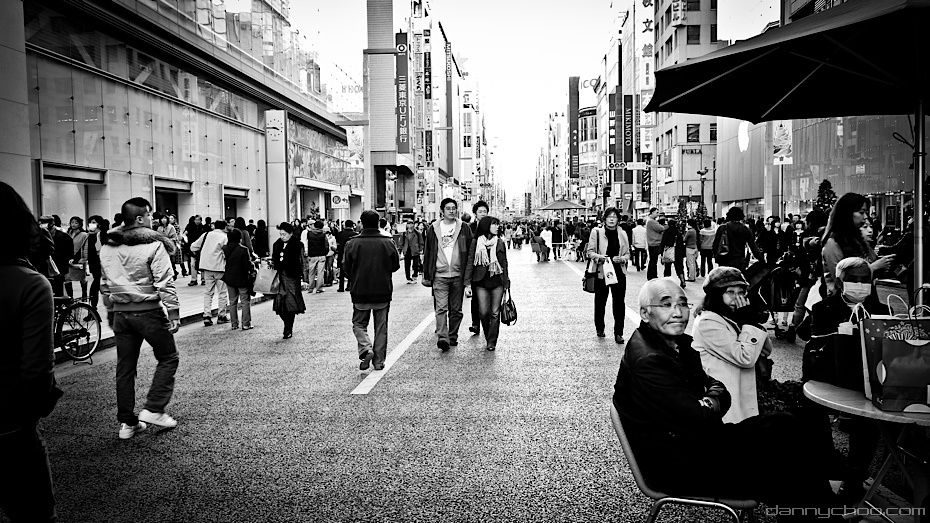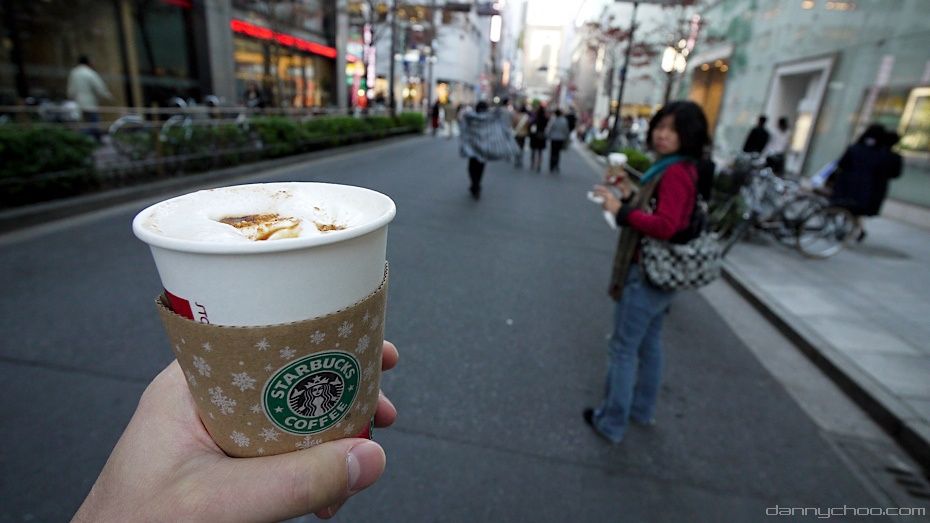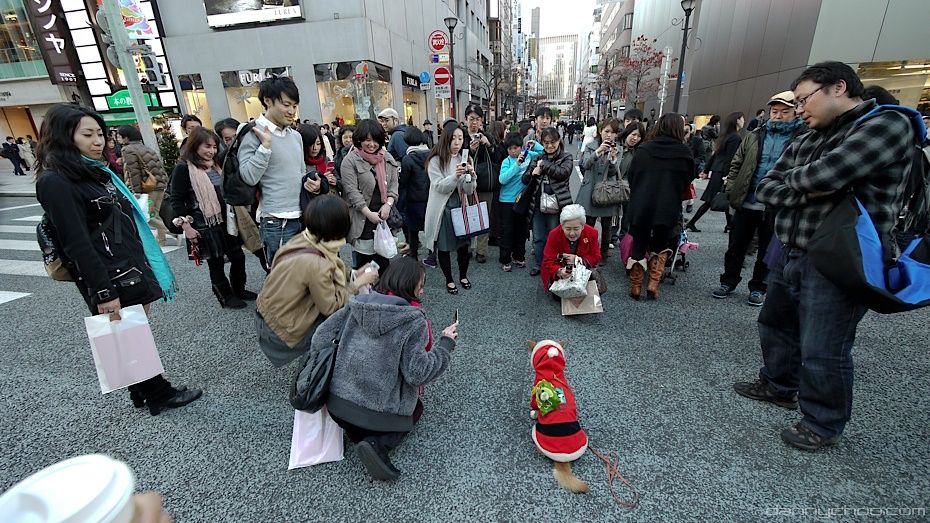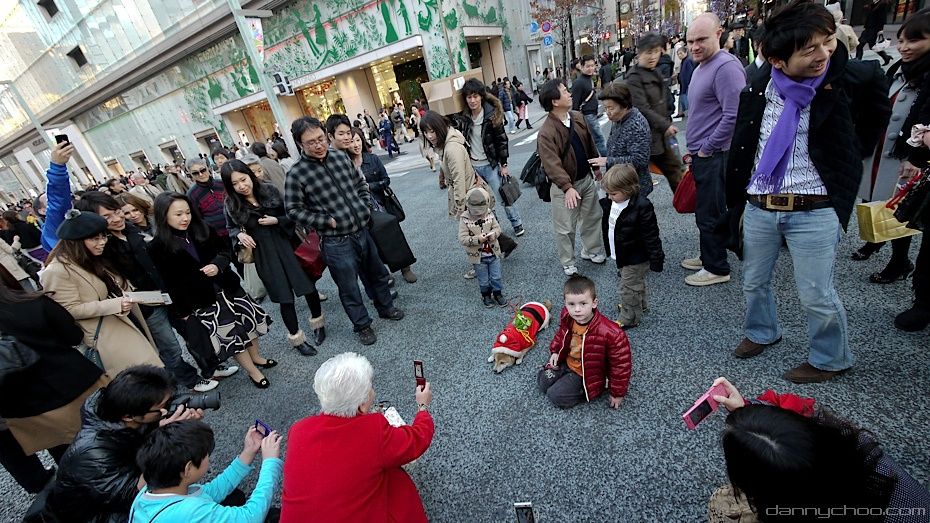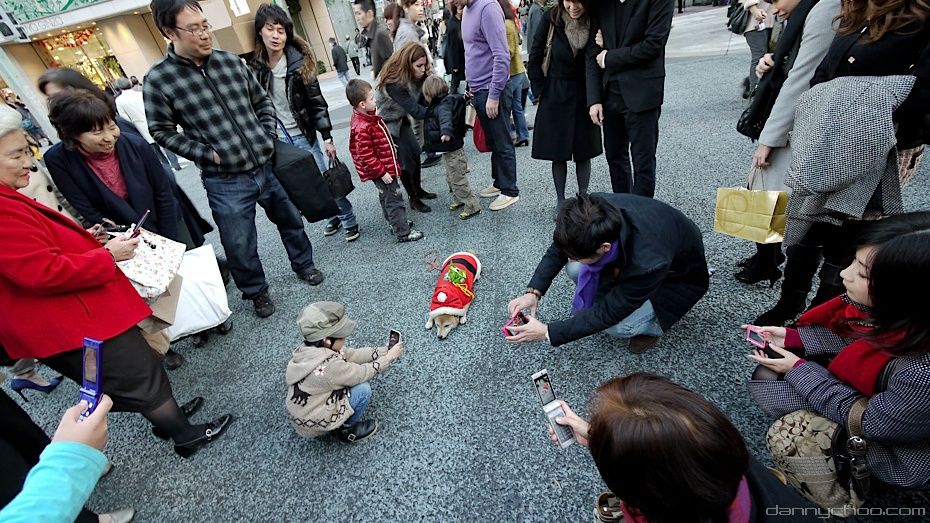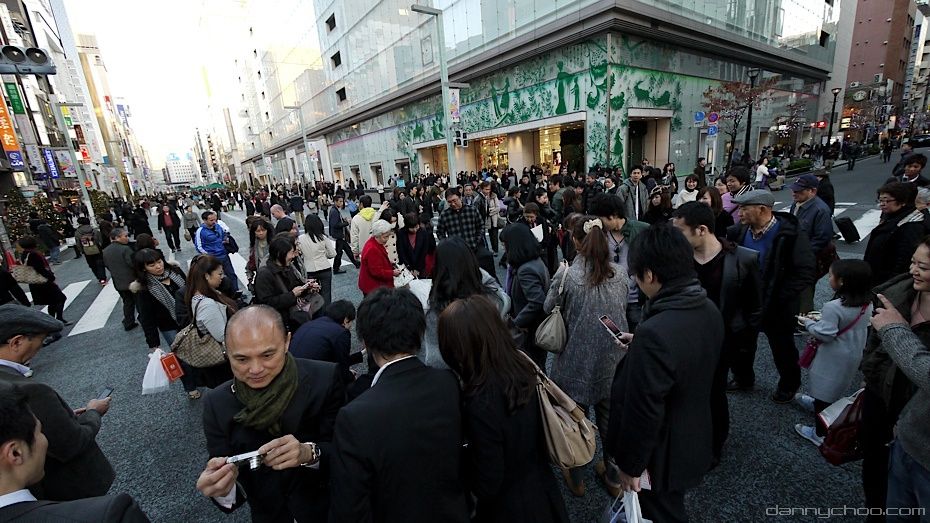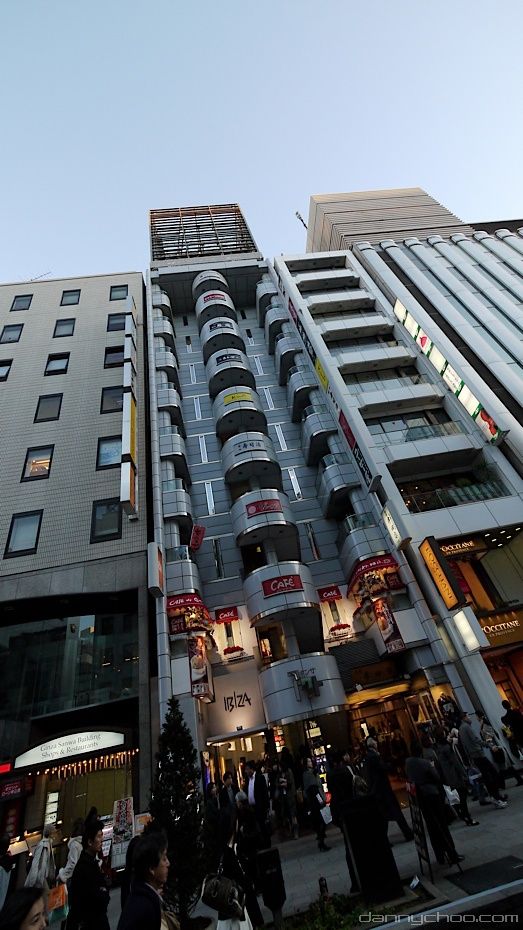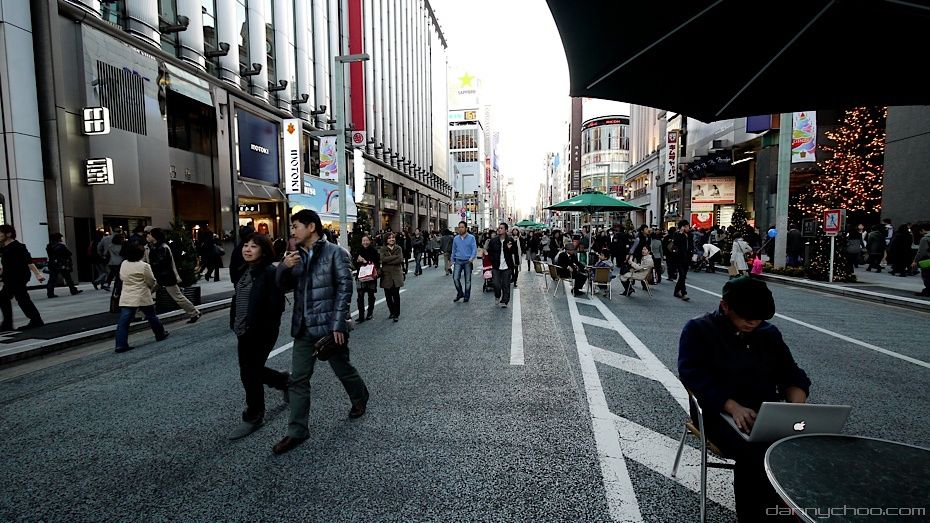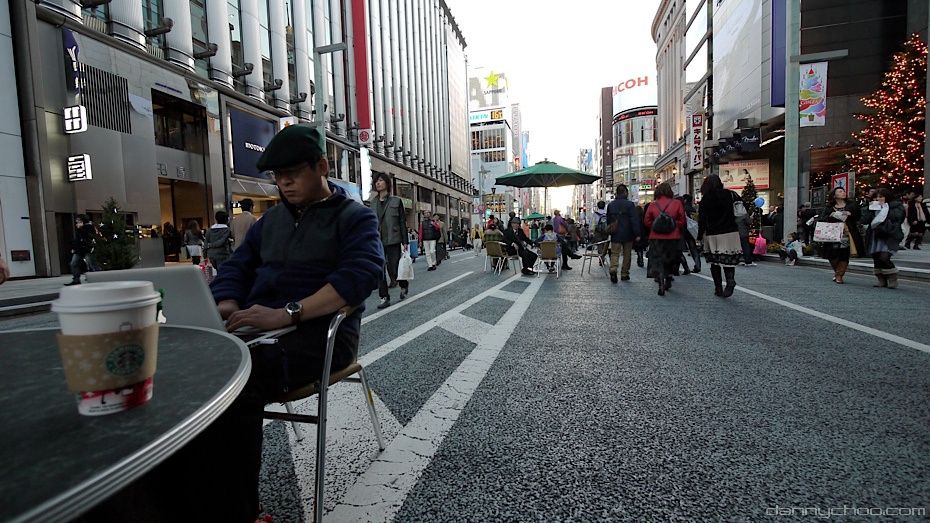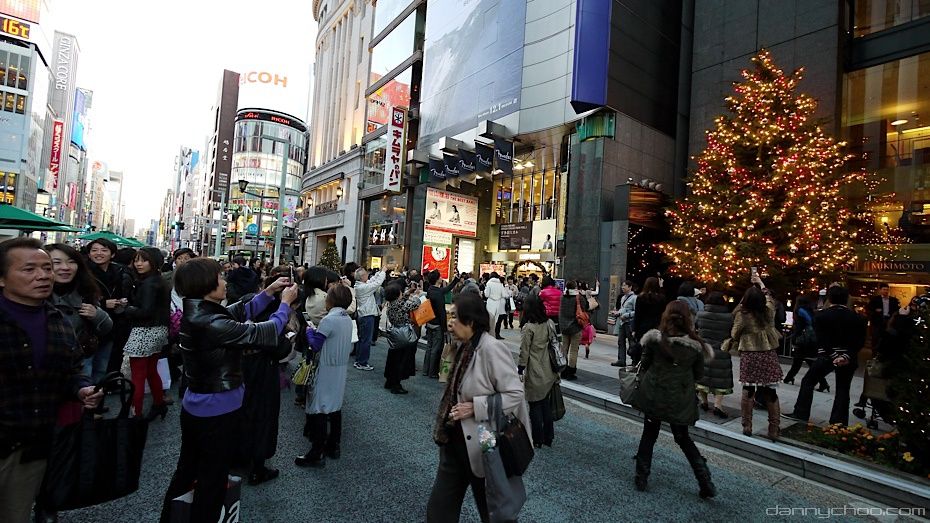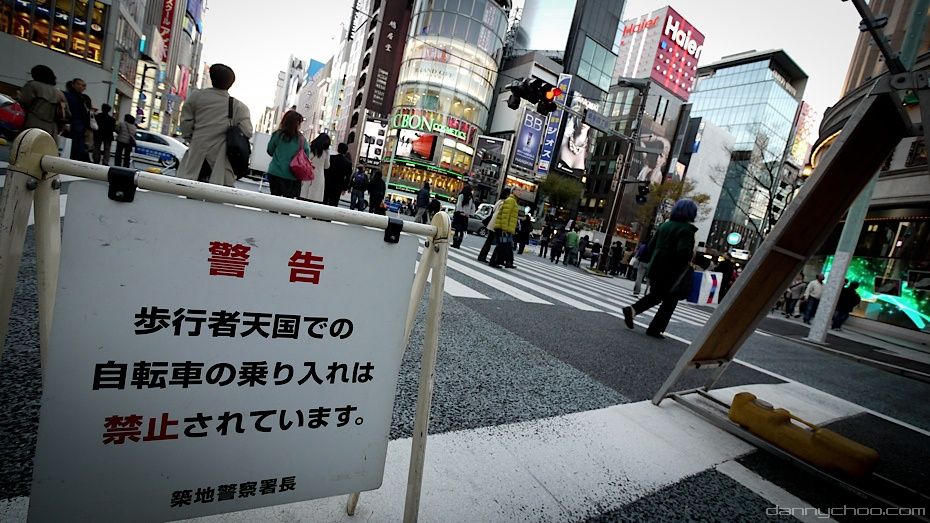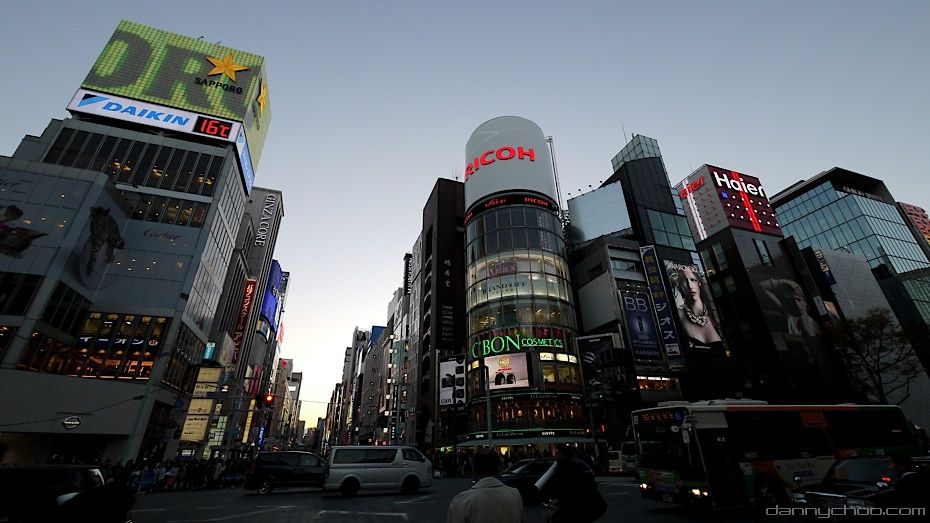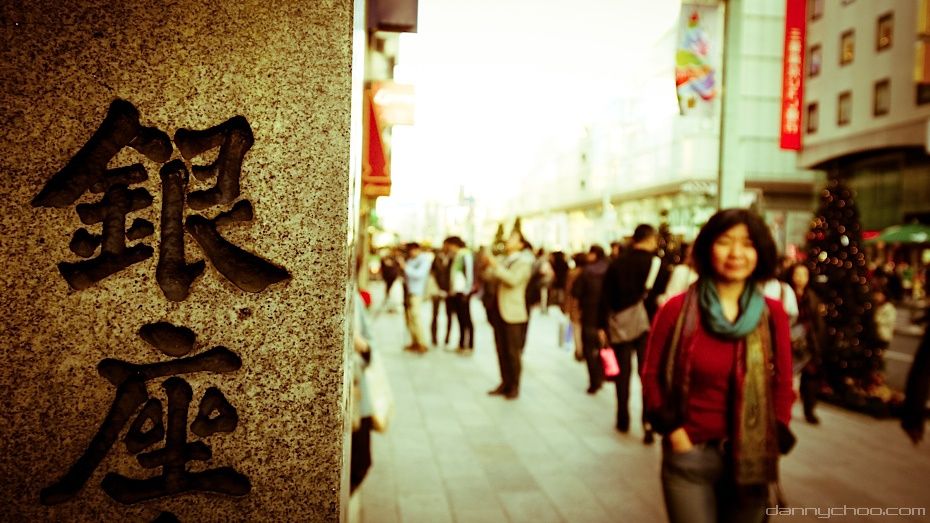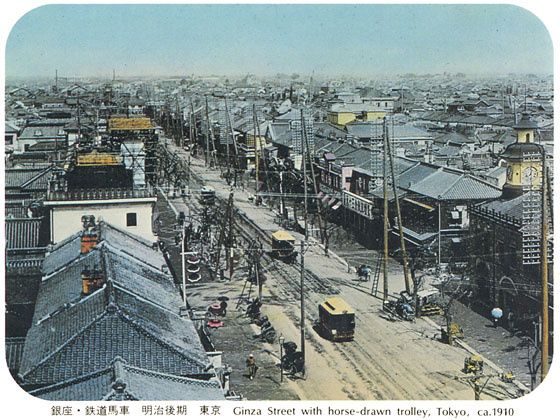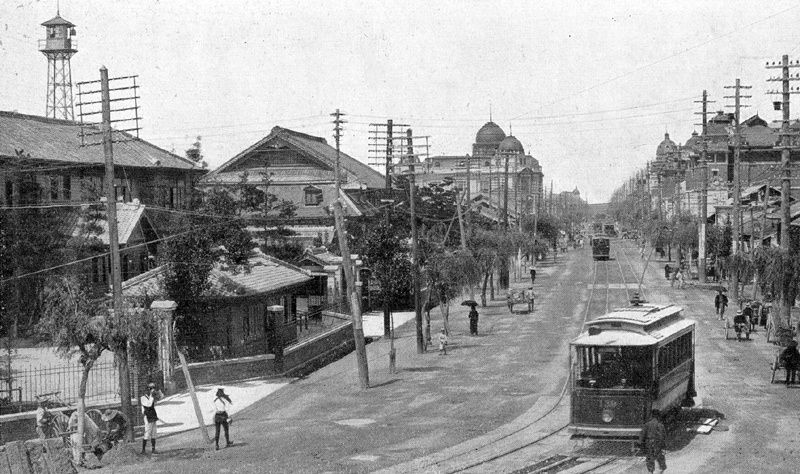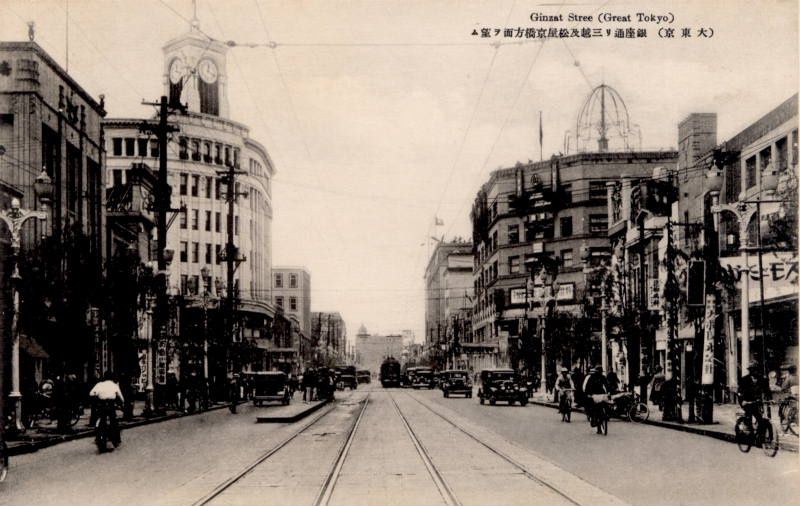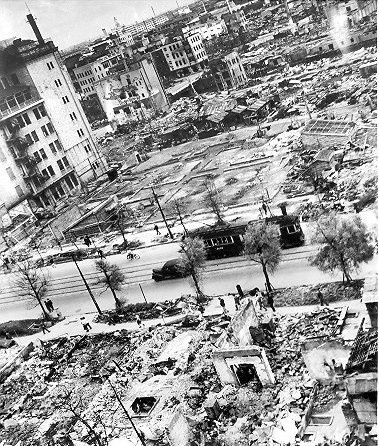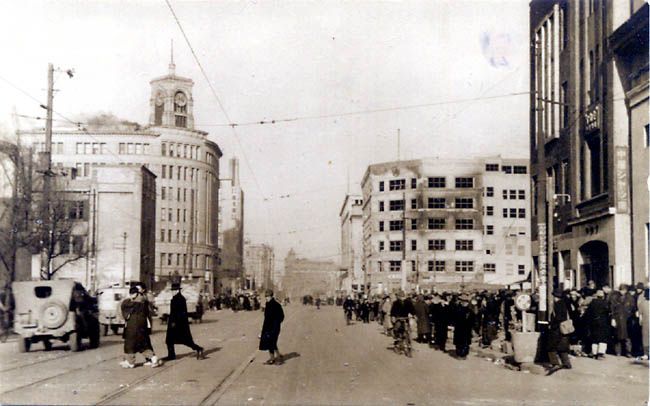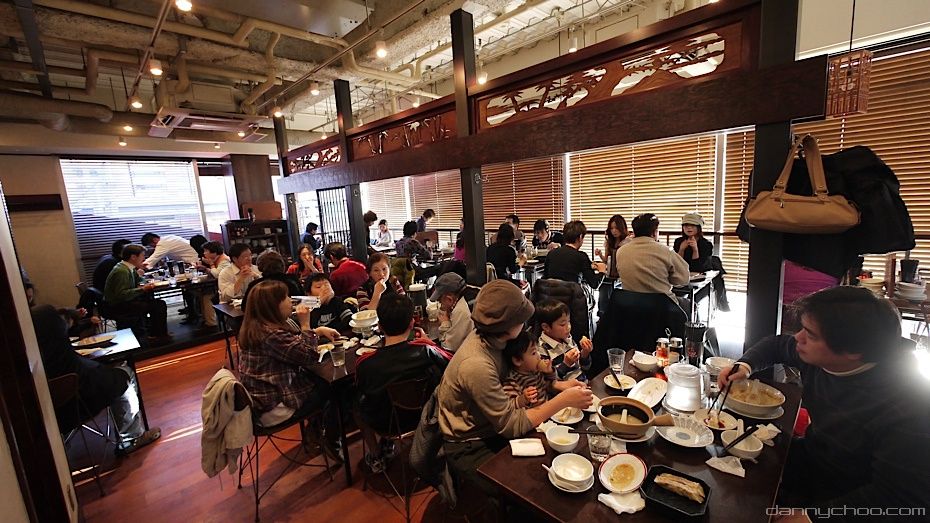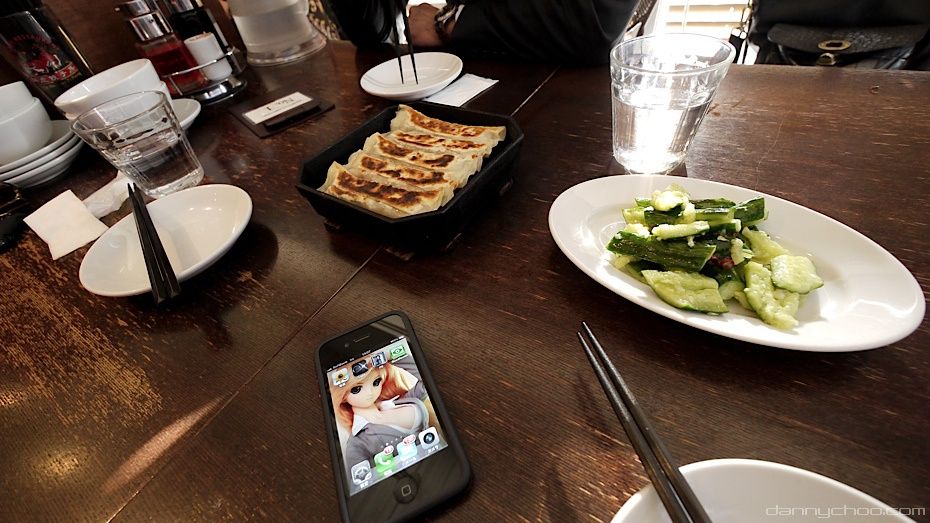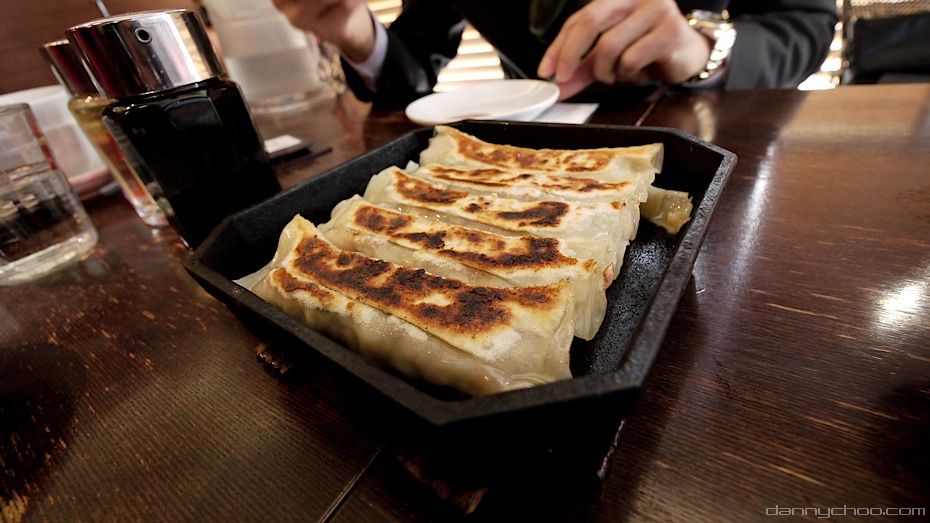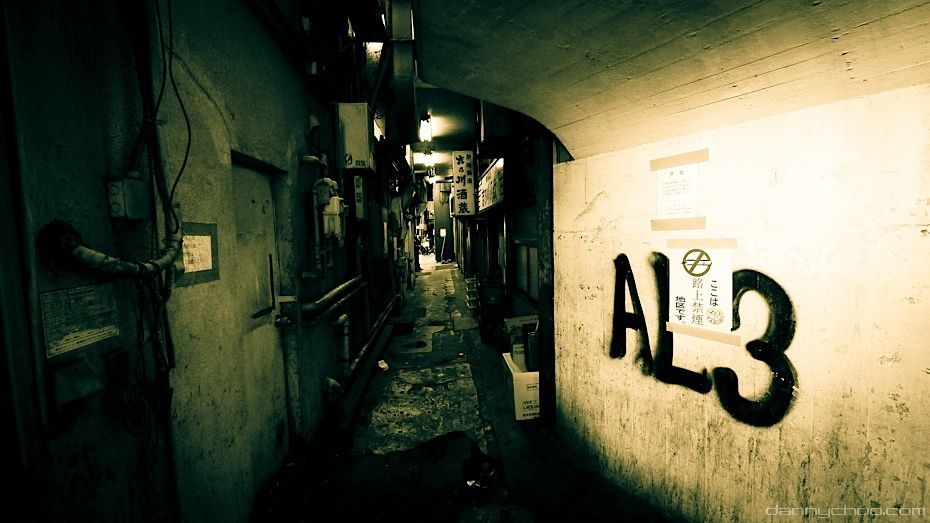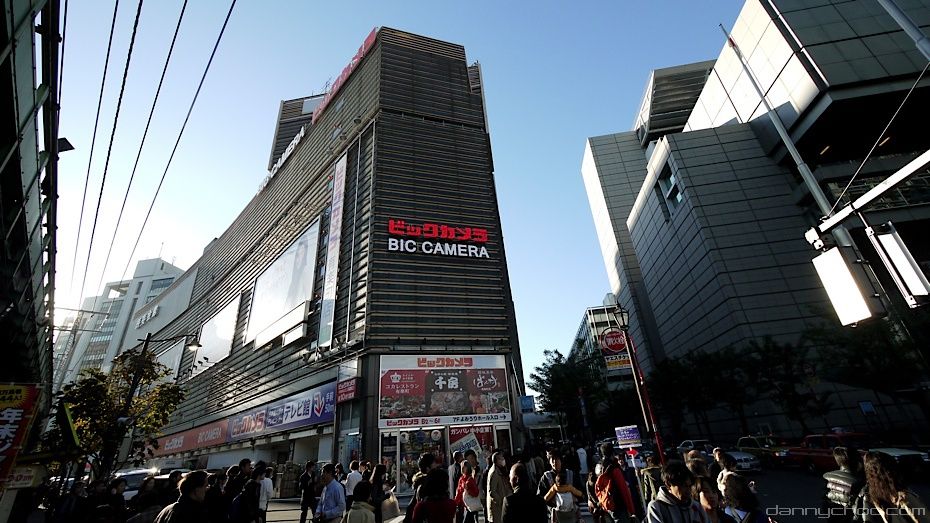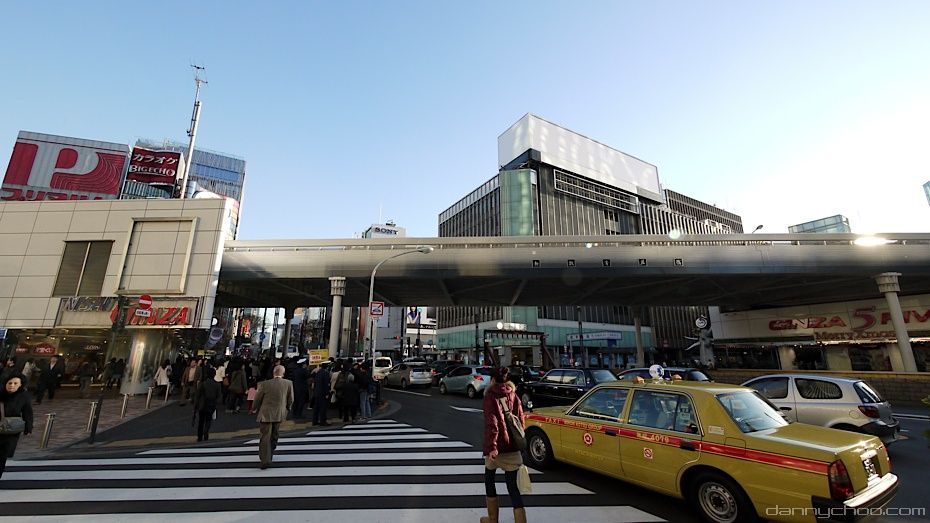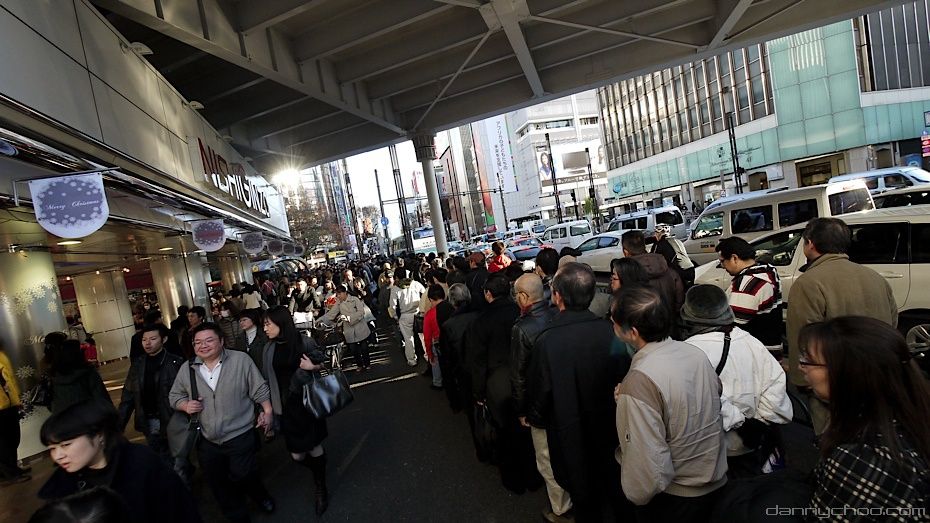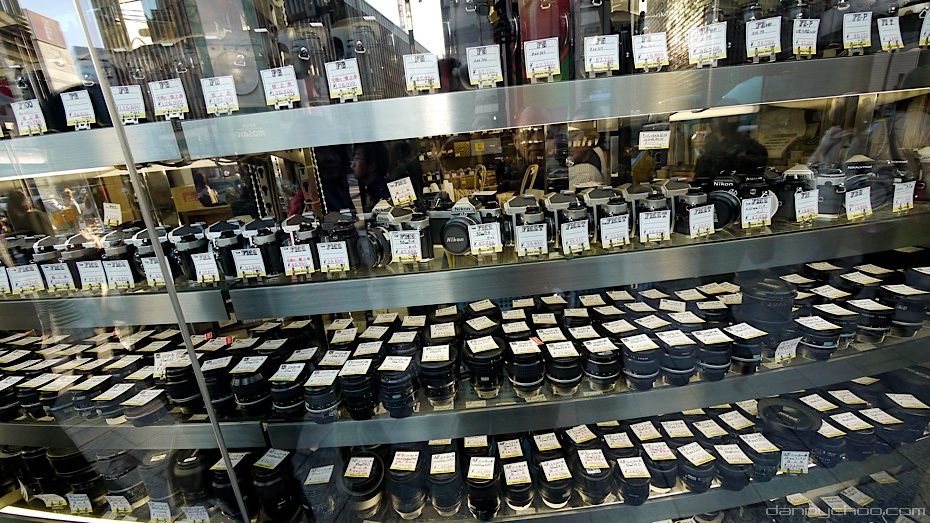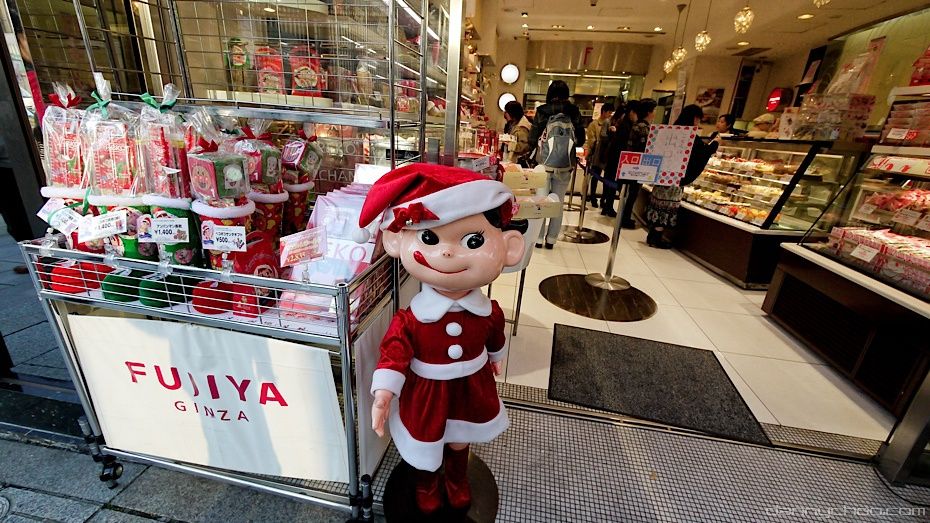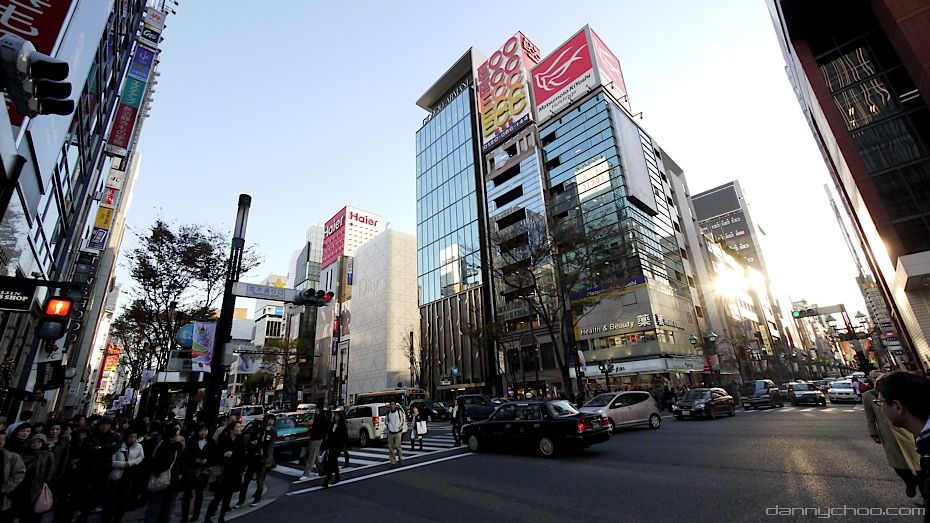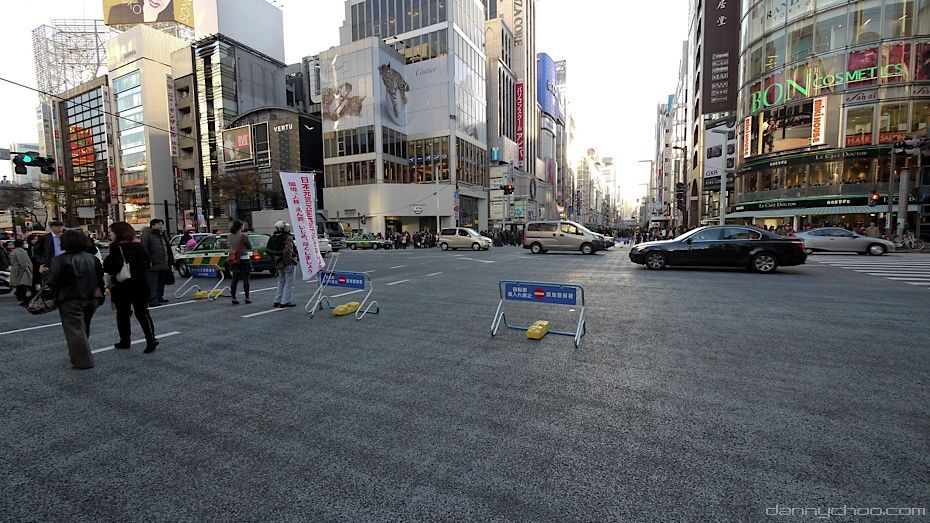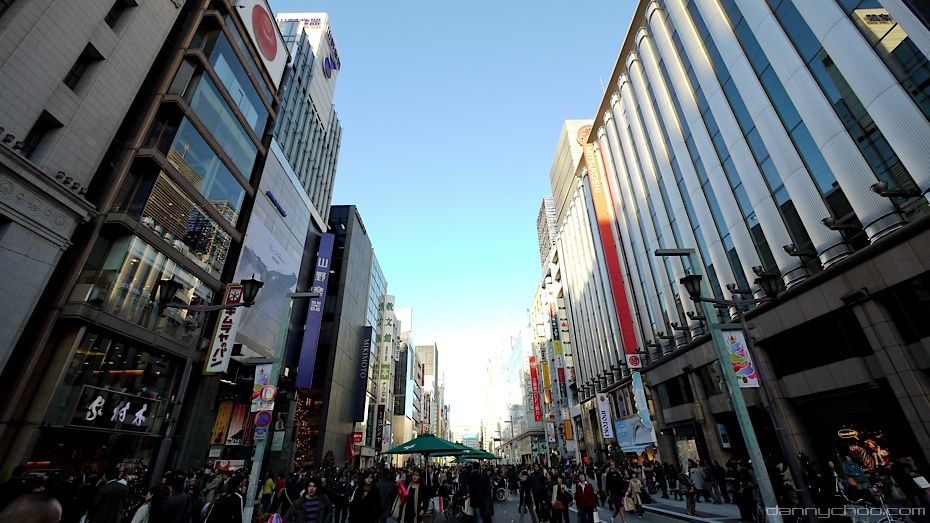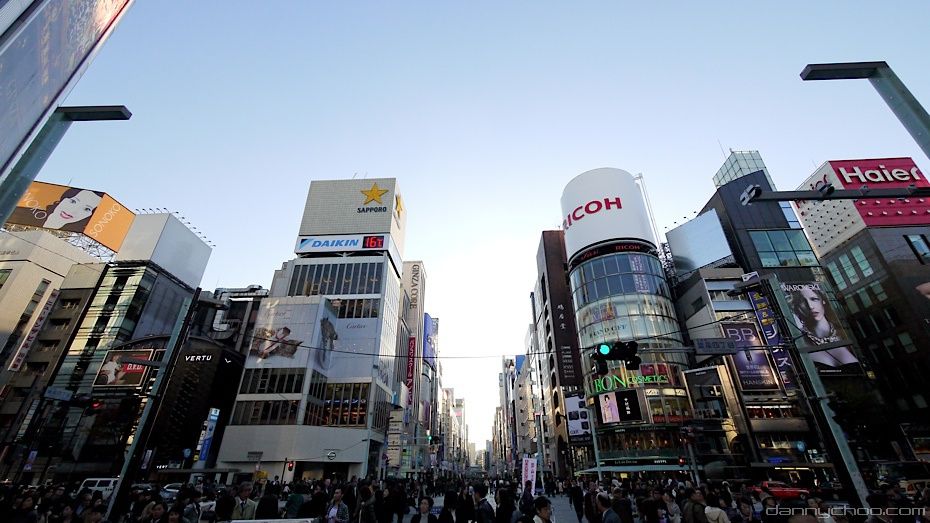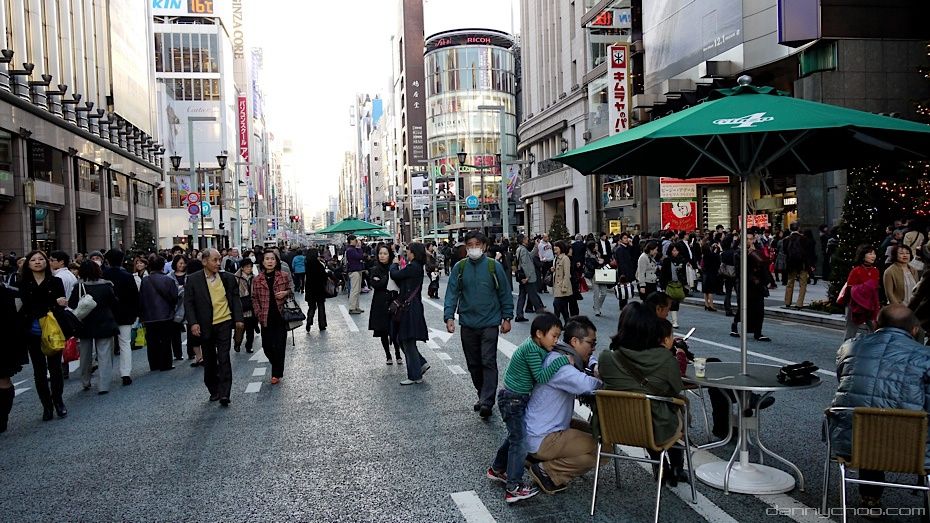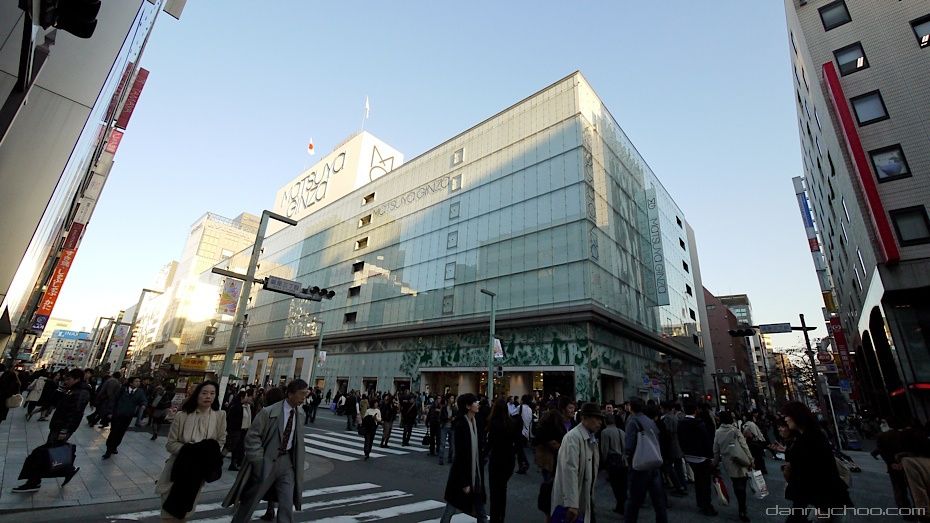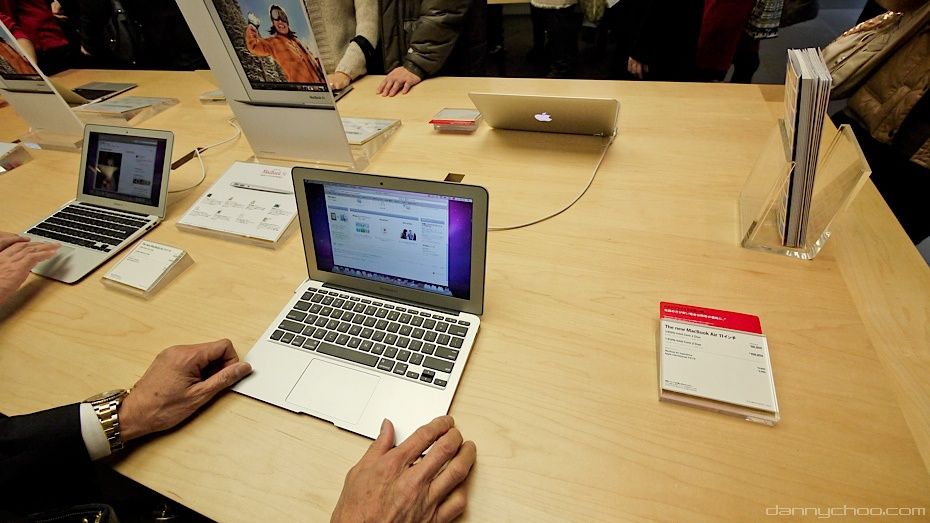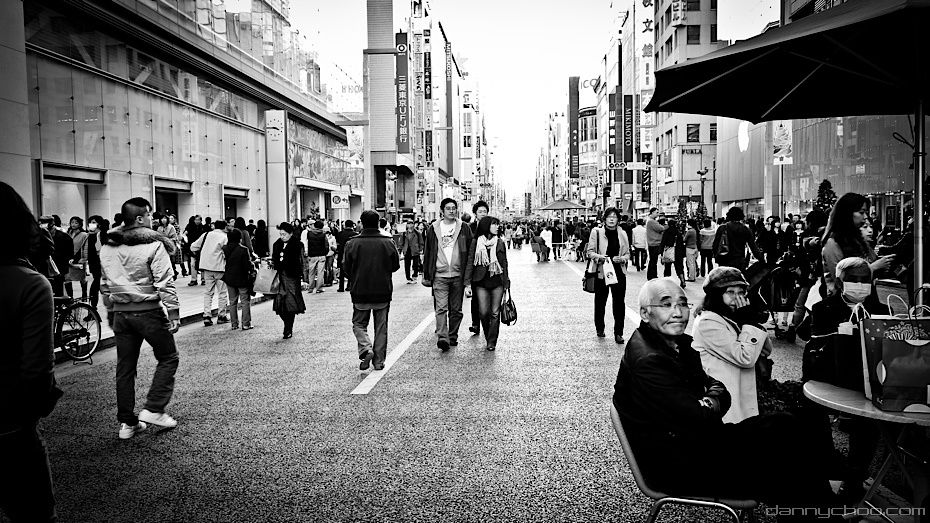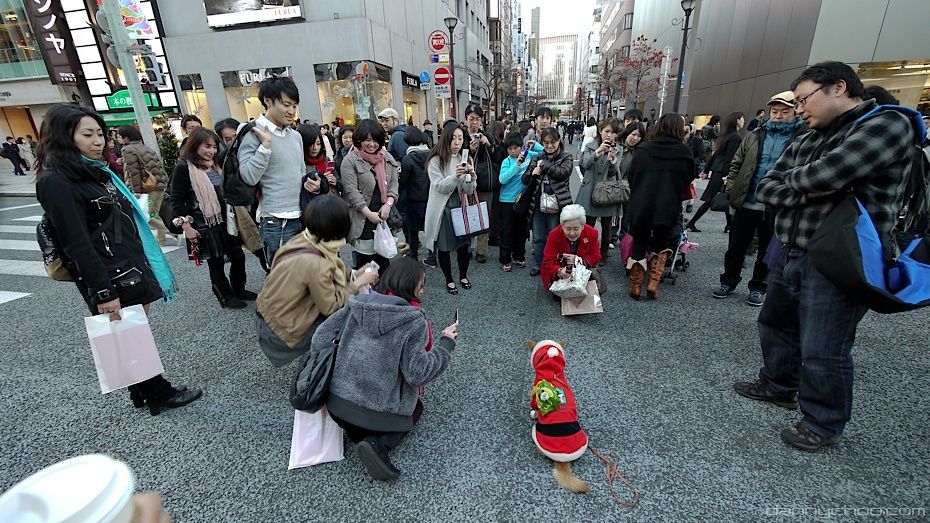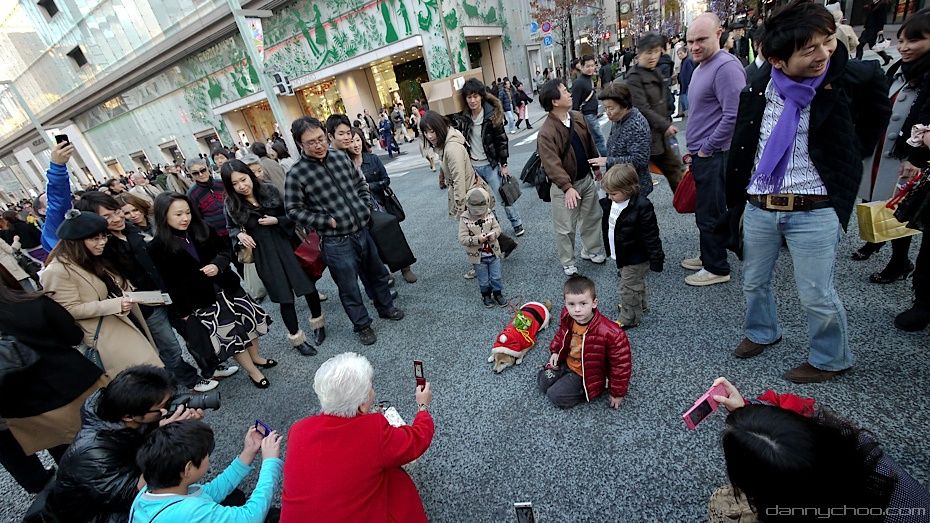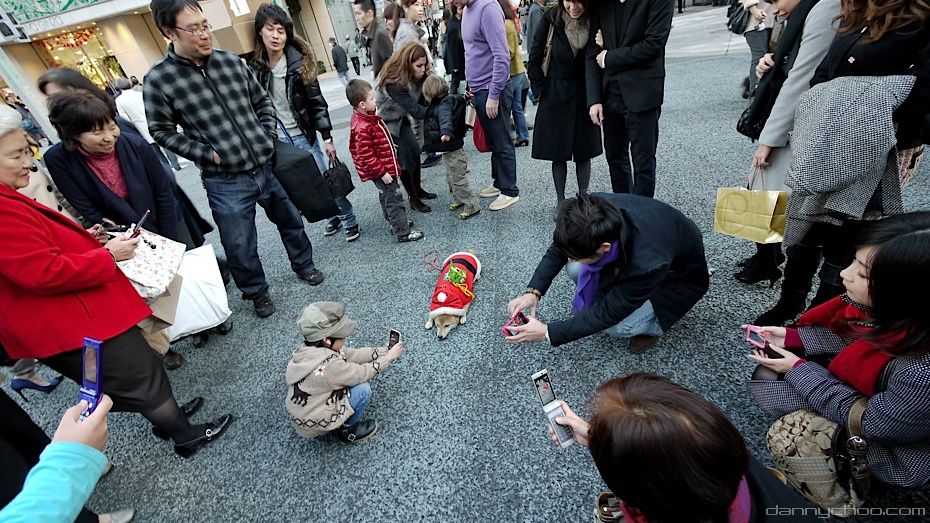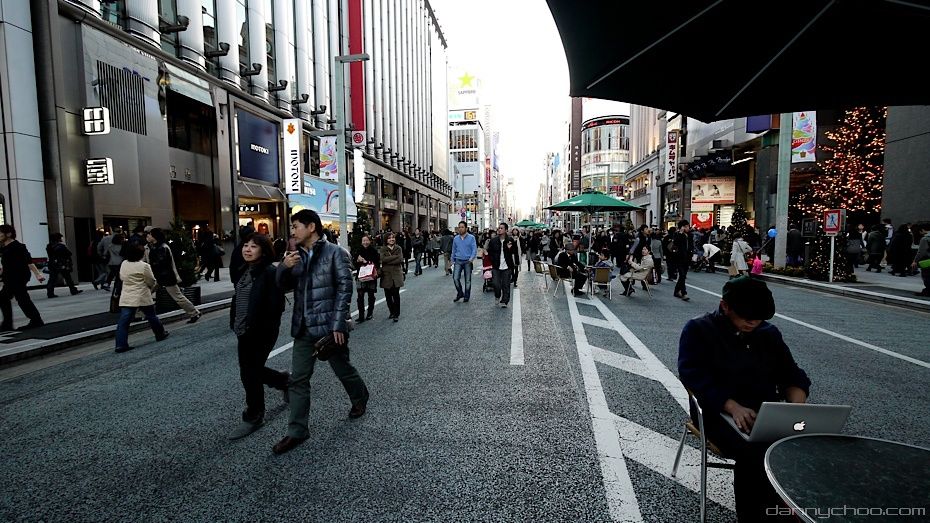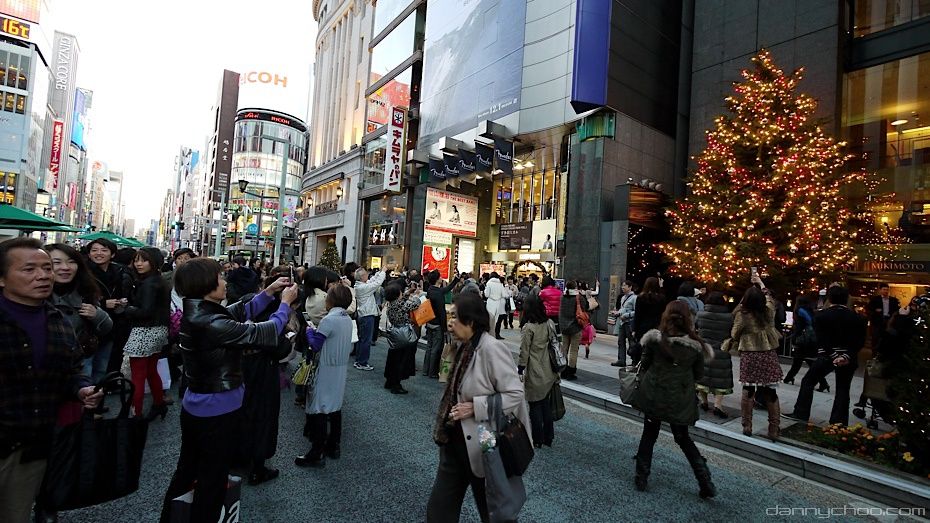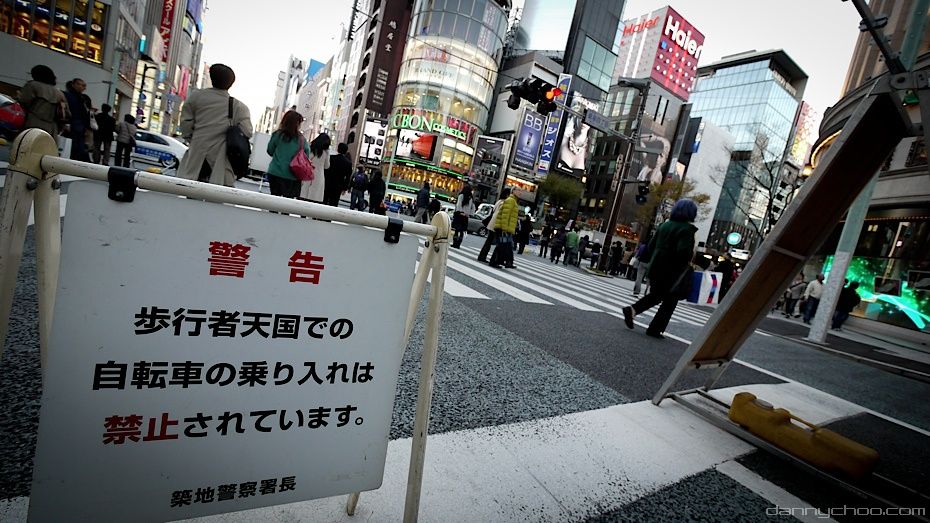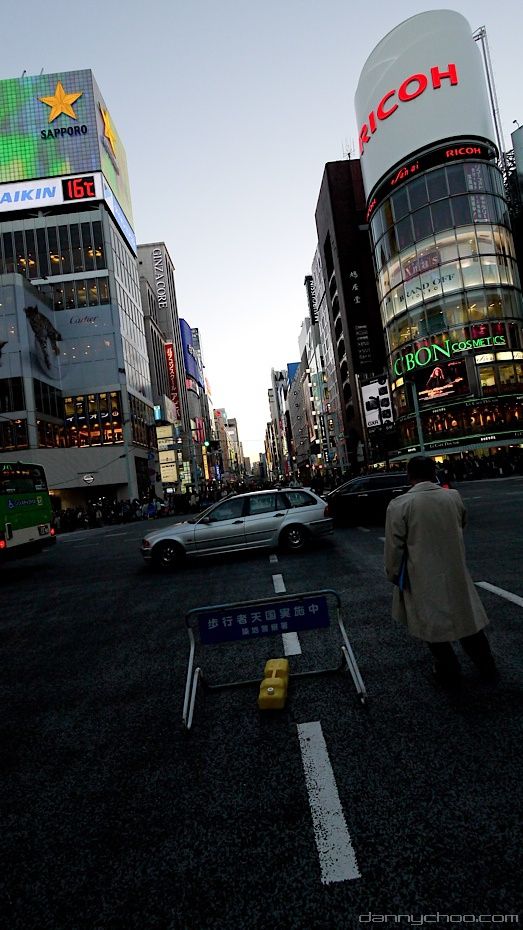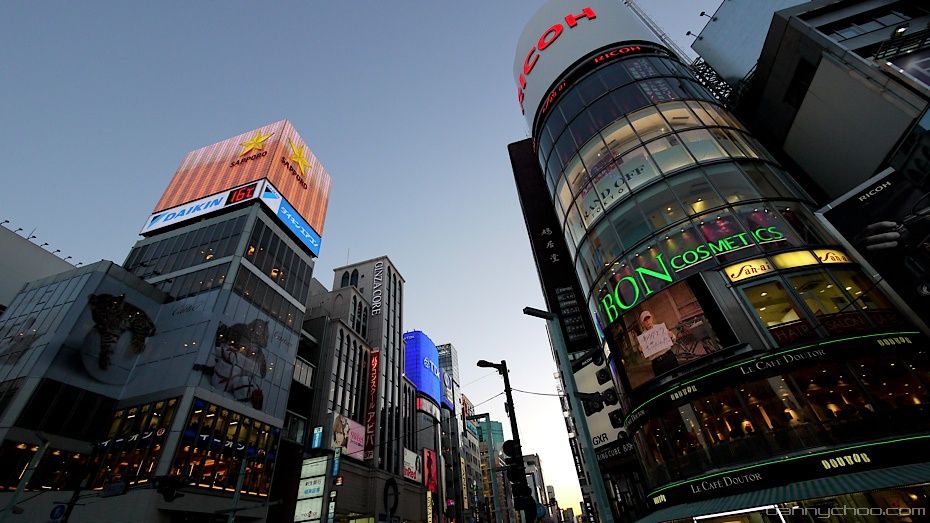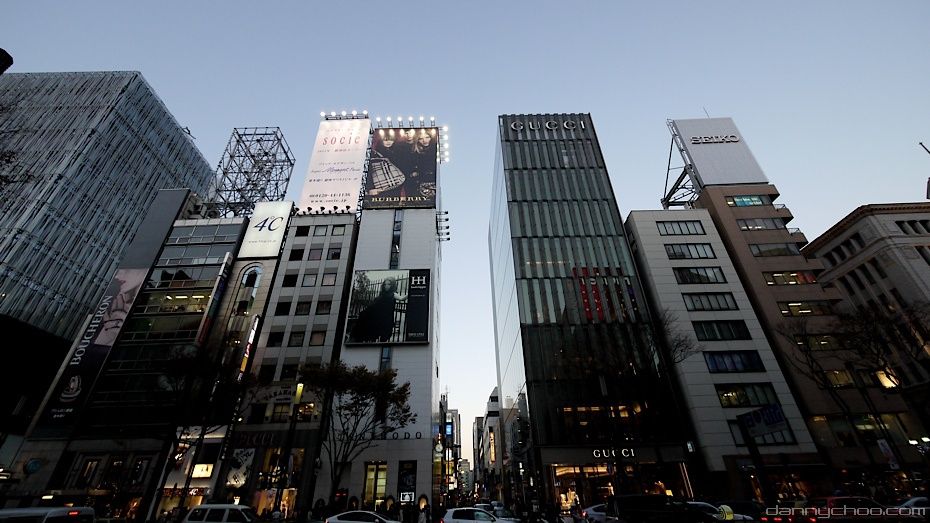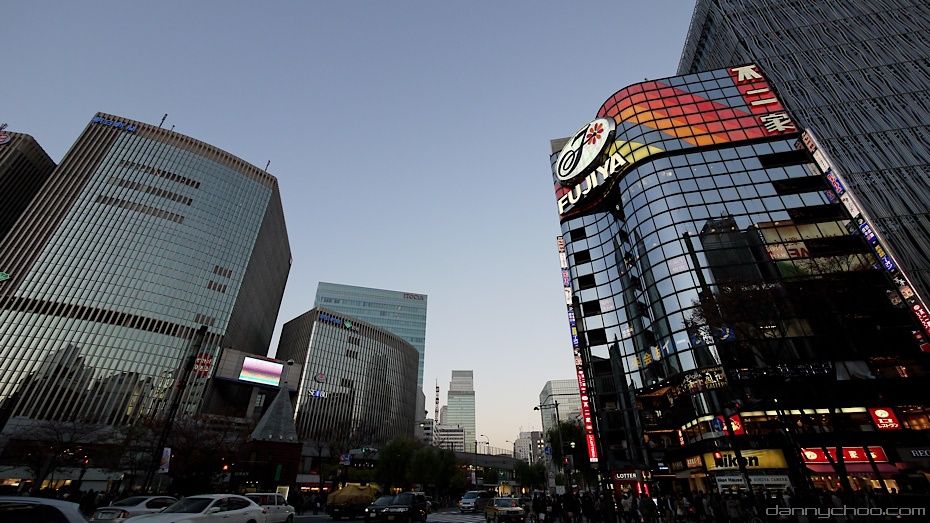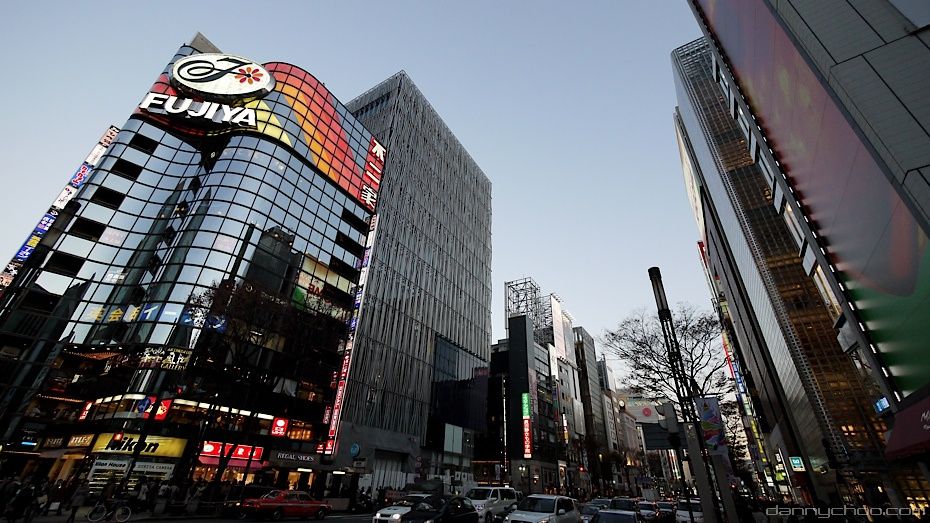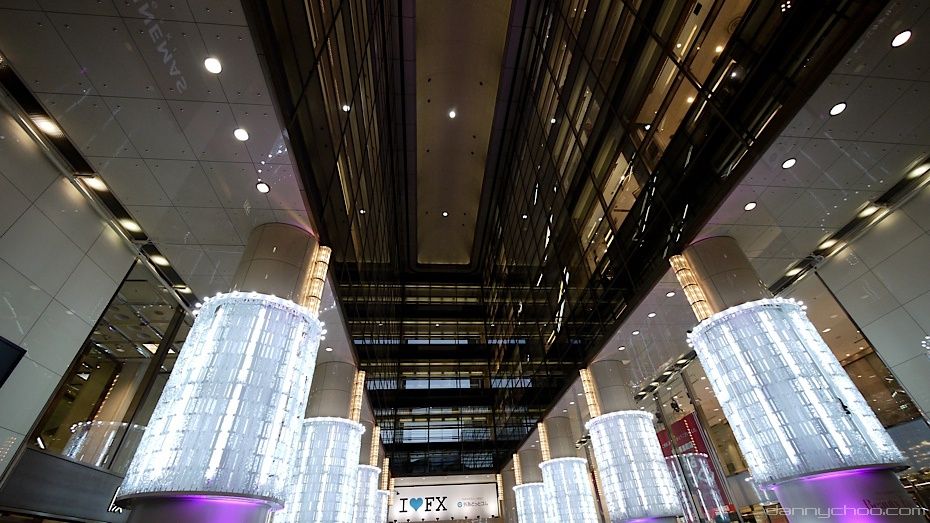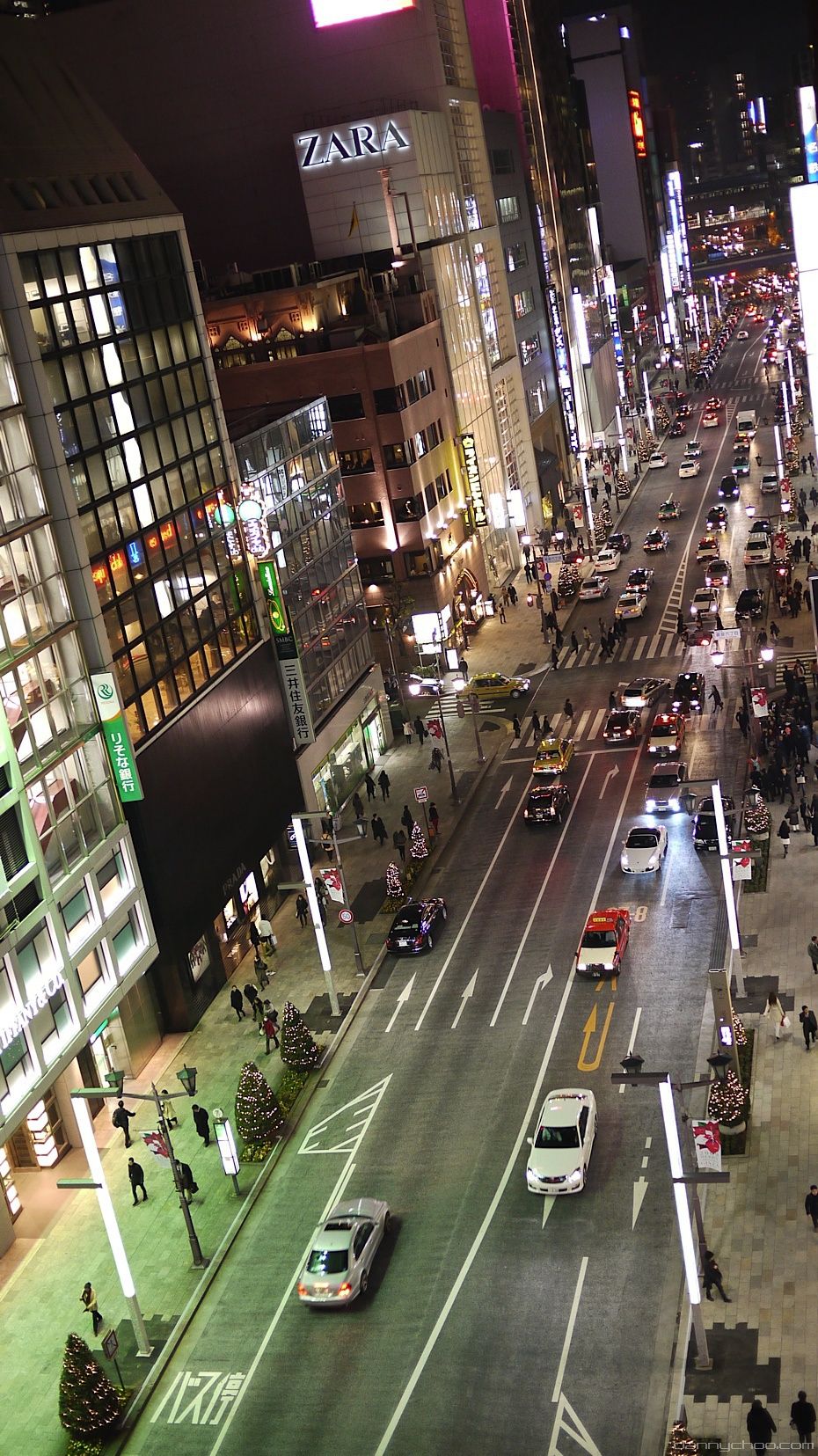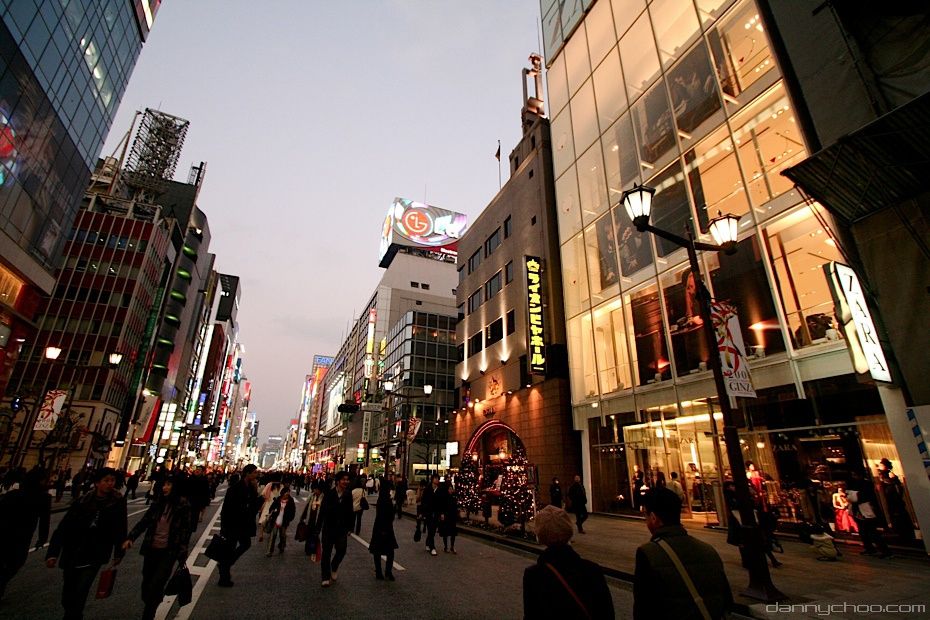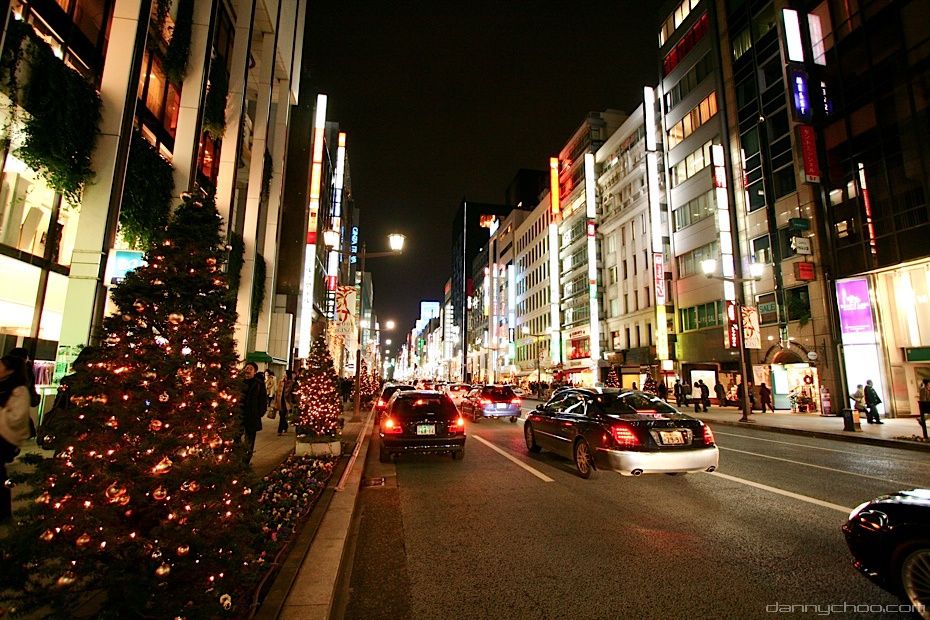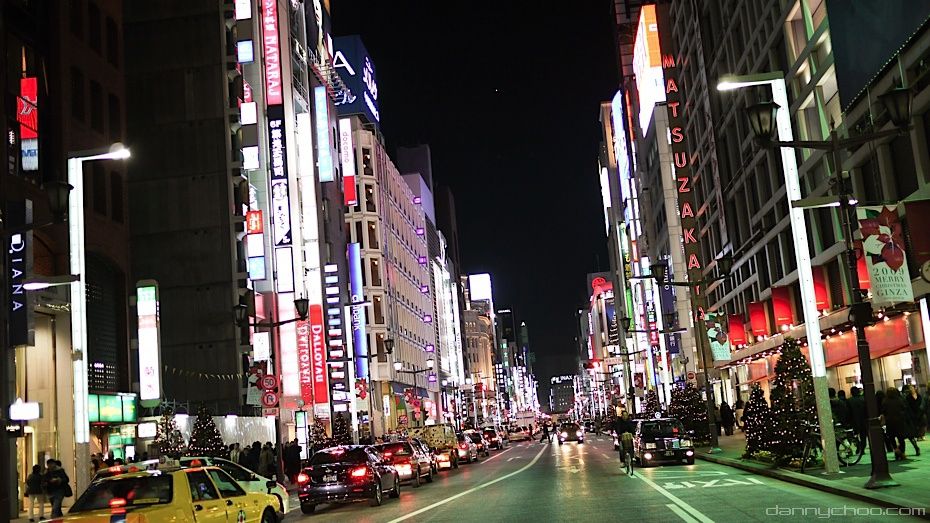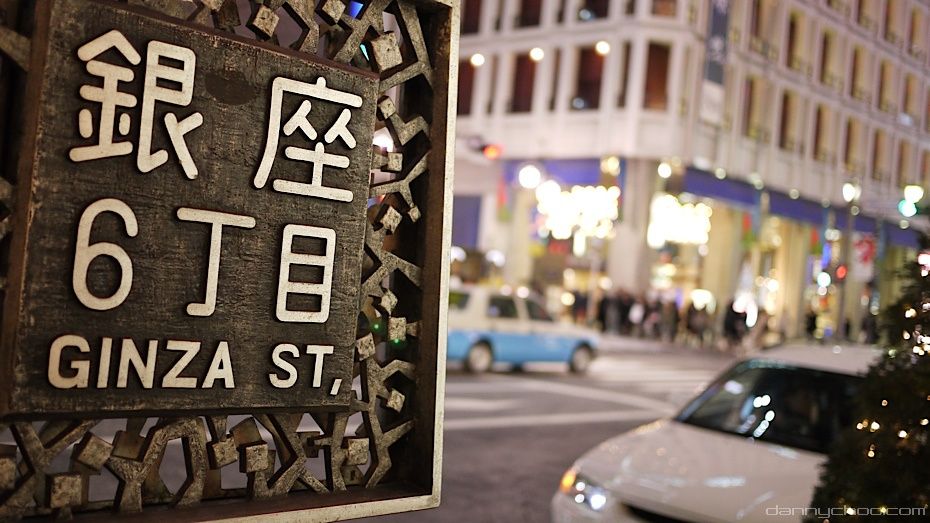Located in the heart of Tokyo is Ginza - a swanky modern area where a load of luxury fashion brands (Japanese and Western) can be found concentrated in and around the main Chuo Dori street. There are also a load of restaurants and coffee shops too to help shoppers recharge their depleted energy cells before continuing to shop or being dragged around shopping.
Folks who want to visit Ginza should go on a Saturday or Sunday afternoon where the main street is pedestrianized for a most pleasant walk. Its just sooo peaceful. Get off at Ginza station.
History of Ginza
The History of Ginza
A Shogun called Tokugawa Ieyasu started to build his government in Edo (Tokyo was originally called "Edo" up until 1868 where it was renamed to "Tokyo" after it became the imperial capital) in 1590. At the time, Ginza was nothing but marshland on a peninsula.
In 1612 under Tokugawa Ieyasu, a silver mint was established in the area which is where the naming "Ginza" originates from but wasn't called Ginza until 1869.
In 1612 under Tokugawa Ieyasu, a silver mint was established in the area which is where the naming "Ginza" originates from but wasn't called Ginza until 1869.
In the 1700's when Ginza was being developed, the area was built in blocks of 120m x 120m and has kept the same grid layout through the years even after the area was burnt down in a huge fire in 1872 (Meiji 5), The Great Kanto Earthquake in 1923 (Taisho 12) and the air bombings in 1945 (Showa 20).
After the huge fire in 1872 (Meiji 5), the Meiji government designated Ginza as a model of modernization with brick buildings instead of wood and better connected streets. The government also wanted Ginza to be the center of Westernization.
Irish-born architect Thomas Waters was commissioned to rebuild the Ginza and is responsible for the design of the many 2 to 3 story Georgian style brick buildings. The area was known as "Renga Gai" meaning "brick town" at the time.
Irish-born architect Thomas Waters was commissioned to rebuild the Ginza and is responsible for the design of the many 2 to 3 story Georgian style brick buildings. The area was known as "Renga Gai" meaning "brick town" at the time.
The photo above is taken in 1910 (Meiji 43) where horses were used to pull the trams on the tracks. Horse pulled trams came into public use in 1897 (Meiji 30).
The above photo taken in 1913 (Taisho 3). By this period, trams are now running on electricity.
Ginza Chuo Dori - the main street that folks who have visited may be familiar with. Snapped in 1921 (Taisho 10) - 2 years before the Great Kanto Earthquake. Trams ran in the Ginza area until 1967 (Showa 42) were their service came to an end after the increased usage of the automobile - trams ended up making traffic conditions worse.
Photo taken right after the The Great Kanto Earthquake in 1923 (Taisho 12) which pretty much destroyed the entire area. Ginza then underwent a huge reconstruction effort which was heavily financed by the government. Most of the brick buildings were also demolished.
The building under construction on the right is Matsuya and opposite is where the Apple store is right now.
The building under construction on the right is Matsuya and opposite is where the Apple store is right now.
Photo taken in 1930 (Showa 5). Just 7 years after the Great Kanto Earthquake.
Photo taken in 1935 (Showa 10) - 13 years after the Great Kanto Earthquake.
Ginza in 1940. By this time, World War II is around the corner. A ban is placed on the production and sales of luxurious goods and restrictions are also placed on lighting up neon signs and street ads. In 1944, the police closed all bars, restaurants and cafes. During this period, soldiers could be seen performing marches through the streets of Ginza.
Photo taken in 1945 (Showa 20) towards the end of the war. Tokyo was to receive a series of bombings which affected Ginza. The bombings took place on March 10, April 28th and May 25th. For a 3rd time, most of Ginza was destroyed.
Photo taken in 1946 (Showa 21). At the end of Word War II, Japan was occupied by the Allied Powers and was the first time in Japanese history that the island was occupied by a foreign power.
Photo taken in 1955 (Showa 30) - 4 years after Japan signed the San Francisco Peace Treaty which made Japan an independent country again.
In many of these photos you will notice the clock tower - its the Hattori Clock Tower which originally stood from 1894 to 1921. It was demolished in 1921 to rebuild a new one but reconstruction was delayed due to the Great Kanto Earthquake. The new clock tower was completed in 1932 (Showa 7).
The clock tower was built by Hattori Kintaro who was the founder of the company which was to become of of the largest watch makers in the world - Seiko.
The clock tower was built by Hattori Kintaro who was the founder of the company which was to become of of the largest watch makers in the world - Seiko.
Pedestrianization is known as "Hokousha Tengoku" and usually lasts for a few hours on a weekend before the cars are let loose again. In August 1970 (Showa 45), Hokosha Tengoku started in 4 locations around Tokyo which were Shinjuku, Ikebukuro, Asakusa and Ginza. On the first day in Ginza (pictured above), over 230,000 people came out to enjoy the company of others for a stroll.
And this is Ginza in 2006 (Heisei 18) with the Hattori Clock Tower in the center of the photo. The land in Ginza is the most expensive in Japan with 1 square meter costing 25000000 yen around the Ginza 4 chome area. Not only is the land expensive, the brand shops will require giving up a few limbs too if you want to buy stuff. The restaurants and cafe prices are reasonable however.
This photo was plucked from the Ginza Xmas post where you can see more Ginza by night photos.
This photo was plucked from the Ginza Xmas post where you can see more Ginza by night photos.
Recently spend a Saturday afternoon in Ginza and as usual went in our trusty Mirai-mobile. We parked a walking distance from Ginza in Yurakucho.
Some Chinese food for lunch.
A back alley in between Yurakucho and Ginza.
Spotted an arcade filled with retro games.
Bic Camera in Yurakucho - on our way over to Ginza.
Cutie Nozomi Sasaki in the new Wilcom ads.
The Seibu department store in Ginza. This reminds me that I need to go and see Yamato.
Ginza on the other side of this bridge.
A load of folks lining up to buy some lottery. Historically, the lottery place in Ginza has sold a load of winning lottery tickets so the chances of becoming a millionaire are much higher if you get them from here. Approximate wait is quite a few hours though.
A load of vintage Nikon cameras and lenses. A vintage Nikon commercial below ^^;
The Fujiya mascot Peko gets a Christmas make over.
I thought that Ginza was only pedestrianized on a Sunday so was (pleasantly) surprised to see the main Chuo Dori street closed off to traffic on a Saturday.
Ginza is like a fiery Phoenix which rose from the ashes after being burnt down to the ground 3 times.
One thing that I've not noticed with other pedestrianized areas is that Ginza sticks out these umbrella tables and chairs for folks to sit and relax. While its a bit chilly in the Winter, it feels most harmonious to sit down with a cuppa hot coffee while watching folks stroll back n forth. An experience that I recommend anybody to try.
At the Apple store.
Dad : Whats this?
Me : The new MacBook Air
Dad : Is it better than my MacBook Air?
Me : Ummmm.
Dad : Whats this?
Me : The new MacBook Air
Dad : Is it better than my MacBook Air?
Me : Ummmm.
Japan is the land where you can leave your bags unattended and (usually) not have to worry about it going missing.
Snapped in roughly the same spot as the Great Kanto Earthquake photo.
Cuppa hot Choco Mocha. Starbucks is located in one of the side streets near Matsuya.
Humans need a permit to perform on the streets - dogs do not.
Many folks around the huge Christmas tree taking photos.
The main crossing in Ginza.
Bicycles are forbidden to enter the pedestrianized area but foreigners don't know that and when they come along on their bicycles, the police (who are watching the crowds from some location) would call out on a megaphone to the cyclists who don't (or pretend not to) speak Japanese.
Located in the heart of Tokyo is Ginza - a swanky modern area where a load of luxury fashion brands (Japanese and Western) can be found concentrated in and around the main Chuo Dori street. There are also a load of restaurants and coffee shops too to help shoppers recharge their depleted energy cells before continuing to shop or being dragged around shopping.
Folks who want to visit Ginza should go on a Saturday or Sunday afternoon where the main street is pedestrianized for a most pleasant walk. Its just sooo peaceful. Get off at Ginza station.
Folks who want to visit Ginza should go on a Saturday or Sunday afternoon where the main street is pedestrianized for a most pleasant walk. Its just sooo peaceful. Get off at Ginza station.
The History of Ginza
A Shogun called Tokugawa Ieyasu started to build his government in Edo (Tokyo was originally called "Edo" up until 1868 where it was renamed to "Tokyo" after it became the imperial capital) in 1590. At the time, Ginza was nothing but marshland on a peninsula.
In 1612 under Tokugawa Ieyasu, a silver mint was established in the area which is where the naming "Ginza" originates from but wasn't called Ginza until 1869.
In 1612 under Tokugawa Ieyasu, a silver mint was established in the area which is where the naming "Ginza" originates from but wasn't called Ginza until 1869.
In the 1700's when Ginza was being developed, the area was built in blocks of 120m x 120m and has kept the same grid layout through the years even after the area was burnt down in a huge fire in 1872 (Meiji 5), The Great Kanto Earthquake in 1923 (Taisho 12) and the air bombings in 1945 (Showa 20).
After the huge fire in 1872 (Meiji 5), the Meiji government designated Ginza as a model of modernization with brick buildings instead of wood and better connected streets. The government also wanted Ginza to be the center of Westernization.
Irish-born architect Thomas Waters was commissioned to rebuild the Ginza and is responsible for the design of the many 2 to 3 story Georgian style brick buildings. The area was known as "Renga Gai" meaning "brick town" at the time.
Irish-born architect Thomas Waters was commissioned to rebuild the Ginza and is responsible for the design of the many 2 to 3 story Georgian style brick buildings. The area was known as "Renga Gai" meaning "brick town" at the time.
The photo above is taken in 1910 (Meiji 43) where horses were used to pull the trams on the tracks. Horse pulled trams came into public use in 1897 (Meiji 30).
The above photo taken in 1913 (Taisho 3). By this period, trams are now running on electricity.
Ginza Chuo Dori - the main street that folks who have visited may be familiar with. Snapped in 1921 (Taisho 10) - 2 years before the Great Kanto Earthquake. Trams ran in the Ginza area until 1967 (Showa 42) were their service came to an end after the increased usage of the automobile - trams ended up making traffic conditions worse.
Photo taken right after the The Great Kanto Earthquake in 1923 (Taisho 12) which pretty much destroyed the entire area. Ginza then underwent a huge reconstruction effort which was heavily financed by the government. Most of the brick buildings were also demolished.
The building under construction on the right is Matsuya and opposite is where the Apple store is right now.
The building under construction on the right is Matsuya and opposite is where the Apple store is right now.
Photo taken in 1930 (Showa 5). Just 7 years after the Great Kanto Earthquake.
Photo taken in 1935 (Showa 10) - 13 years after the Great Kanto Earthquake.
Ginza in 1940. By this time, World War II is around the corner. A ban is placed on the production and sales of luxurious goods and restrictions are also placed on lighting up neon signs and street ads. In 1944, the police closed all bars, restaurants and cafes. During this period, soldiers could be seen performing marches through the streets of Ginza.
Photo taken in 1945 (Showa 20) towards the end of the war. Tokyo was to receive a series of bombings which affected Ginza. The bombings took place on March 10, April 28th and May 25th. For a 3rd time, most of Ginza was destroyed.
Photo taken in 1946 (Showa 21). At the end of Word War II, Japan was occupied by the Allied Powers and was the first time in Japanese history that the island was occupied by a foreign power.
Photo taken in 1955 (Showa 30) - 4 years after Japan signed the San Francisco Peace Treaty which made Japan an independent country again.
In many of these photos you will notice the clock tower - its the Hattori Clock Tower which originally stood from 1894 to 1921. It was demolished in 1921 to rebuild a new one but reconstruction was delayed due to the Great Kanto Earthquake. The new clock tower was completed in 1932 (Showa 7).
The clock tower was built by Hattori Kintaro who was the founder of the company which was to become of of the largest watch makers in the world - Seiko.
The clock tower was built by Hattori Kintaro who was the founder of the company which was to become of of the largest watch makers in the world - Seiko.
Pedestrianization is known as "Hokousha Tengoku" and usually lasts for a few hours on a weekend before the cars are let loose again. In August 1970 (Showa 45), Hokosha Tengoku started in 4 locations around Tokyo which were Shinjuku, Ikebukuro, Asakusa and Ginza. On the first day in Ginza (pictured above), over 230,000 people came out to enjoy the company of others for a stroll.
And this is Ginza in 2006 (Heisei 18) with the Hattori Clock Tower in the center of the photo. The land in Ginza is the most expensive in Japan with 1 square meter costing 25000000 yen around the Ginza 4 chome area. Not only is the land expensive, the brand shops will require giving up a few limbs too if you want to buy stuff. The restaurants and cafe prices are reasonable however.
This photo was plucked from the Ginza Xmas post where you can see more Ginza by night photos.
This photo was plucked from the Ginza Xmas post where you can see more Ginza by night photos.
Recently spend a Saturday afternoon in Ginza and as usual went in our trusty Mirai-mobile. We parked a walking distance from Ginza in Yurakucho.
Some Chinese food for lunch.
A back alley in between Yurakucho and Ginza.
Spotted an arcade filled with retro games.
Bic Camera in Yurakucho - on our way over to Ginza.
Cutie Nozomi Sasaki in the new Wilcom ads.
The Seibu department store in Ginza. This reminds me that I need to go and see Yamato.
Ginza on the other side of this bridge.
A load of folks lining up to buy some lottery. Historically, the lottery place in Ginza has sold a load of winning lottery tickets so the chances of becoming a millionaire are much higher if you get them from here. Approximate wait is quite a few hours though.
A load of vintage Nikon cameras and lenses. A vintage Nikon commercial below ^^;
The Fujiya mascot Peko gets a Christmas make over.
I thought that Ginza was only pedestrianized on a Sunday so was (pleasantly) surprised to see the main Chuo Dori street closed off to traffic on a Saturday.
Ginza is like a fiery Phoenix which rose from the ashes after being burnt down to the ground 3 times.
One thing that I've not noticed with other pedestrianized areas is that Ginza sticks out these umbrella tables and chairs for folks to sit and relax. While its a bit chilly in the Winter, it feels most harmonious to sit down with a cuppa hot coffee while watching folks stroll back n forth. An experience that I recommend anybody to try.
At the Apple store.
Dad : Whats this?
Me : The new MacBook Air
Dad : Is it better than my MacBook Air?
Me : Ummmm.
Dad : Whats this?
Me : The new MacBook Air
Dad : Is it better than my MacBook Air?
Me : Ummmm.
Japan is the land where you can leave your bags unattended and (usually) not have to worry about it going missing.
Snapped in roughly the same spot as the Great Kanto Earthquake photo.
Cuppa hot Choco Mocha. Starbucks is located in one of the side streets near Matsuya.
Humans need a permit to perform on the streets - dogs do not.
Many folks around the huge Christmas tree taking photos.
The main crossing in Ginza.
Bicycles are forbidden to enter the pedestrianized area but foreigners don't know that and when they come along on their bicycles, the police (who are watching the crowds from some location) would call out on a megaphone to the cyclists who don't (or pretend not to) speak Japanese.
And more Ginza by night photos in the Ginza and Ginza Xmas posts.
This article is posted in the Places to visit category and you can see more below.
Old photos in this post nabbed from the following sources and you can see more photos that I took in the Ginza and Ginza Xmas posts.
http://blogs.yahoo.co.jp/dokidoki\_puck/12858154.html
http://www.geocities.jp/a1115b/sub39.htm
http://www.chuo-kanko.or.jp/knowledge/town/town\_02.html
http://showa.mainichi.jp/comeback/2008/08/post-b486.html
http://www.metro.tokyo.jp/SUB/PHOTO/TOKYO\_ARCHIVE/index.html
http://network2010.org/nc400/rensai/hirokojistory/sengo/sengo10.html
http://blog.livedoor.jp/tsutsumikiyoaki/archives/1123842.html
http://www.keiogakuyukai.com/Archive-63-Ozasa.htm
http://www.geocities.jp/torikai007/war/1945/hiroshima.html
http://www.oldtokyo.com/ginza-crossing.html
http://blogs.yahoo.co.jp/dokidoki\_puck/12858154.html
http://www.geocities.jp/a1115b/sub39.htm
http://www.chuo-kanko.or.jp/knowledge/town/town\_02.html
http://showa.mainichi.jp/comeback/2008/08/post-b486.html
http://www.metro.tokyo.jp/SUB/PHOTO/TOKYO\_ARCHIVE/index.html
http://network2010.org/nc400/rensai/hirokojistory/sengo/sengo10.html
http://blog.livedoor.jp/tsutsumikiyoaki/archives/1123842.html
http://www.keiogakuyukai.com/Archive-63-Ozasa.htm
http://www.geocities.jp/torikai007/war/1945/hiroshima.html
http://www.oldtokyo.com/ginza-crossing.html



